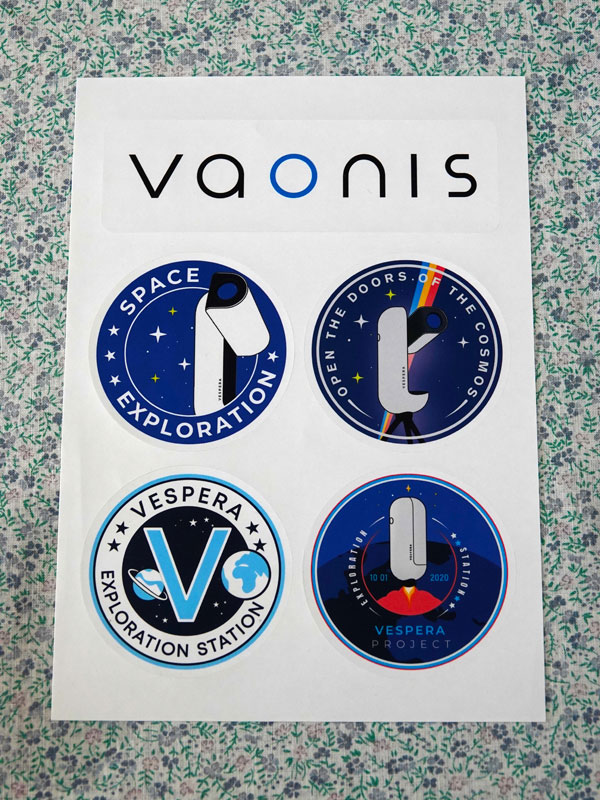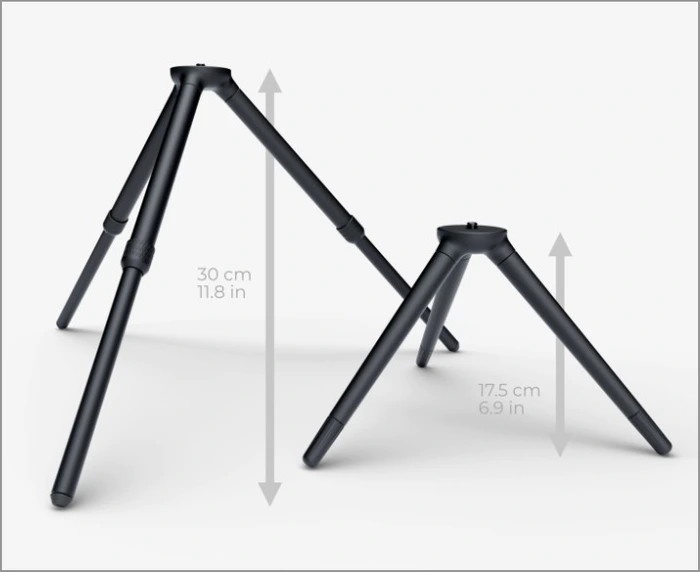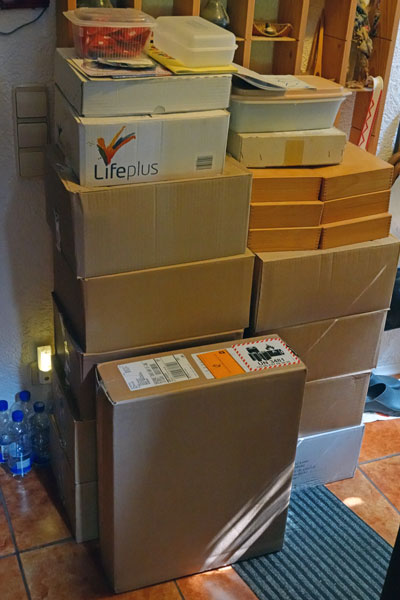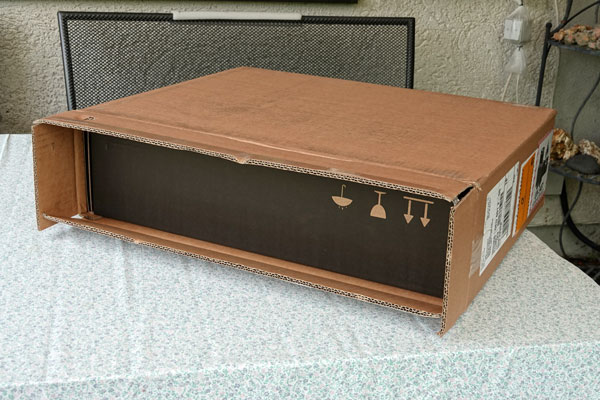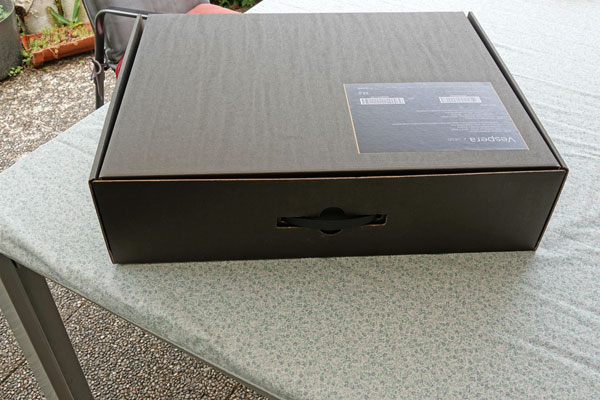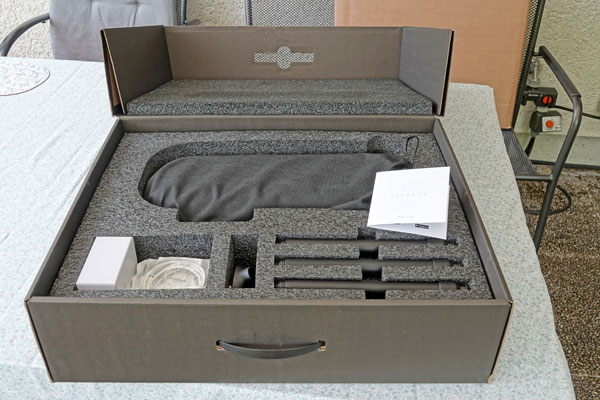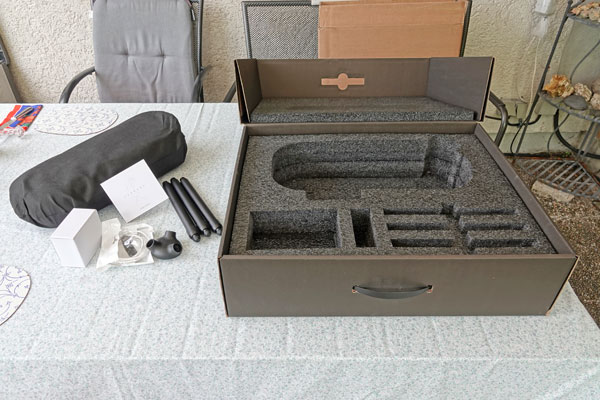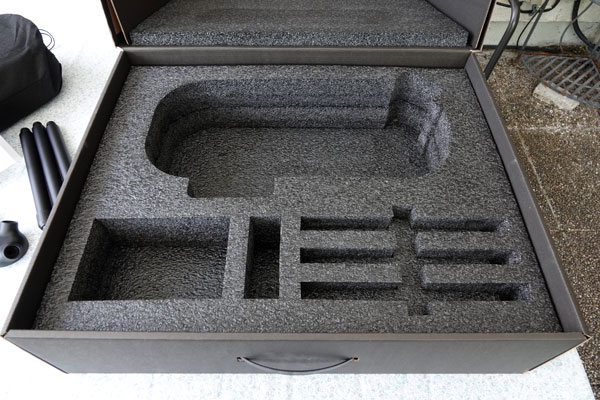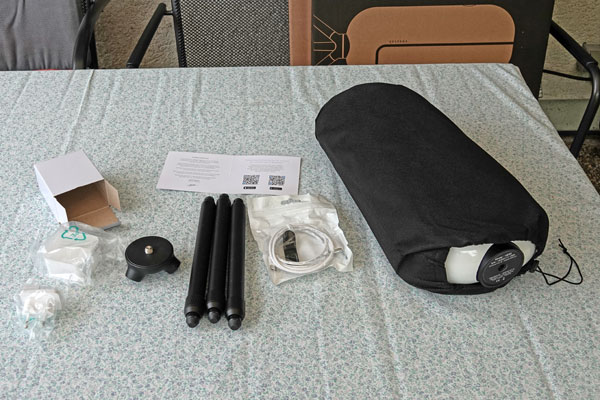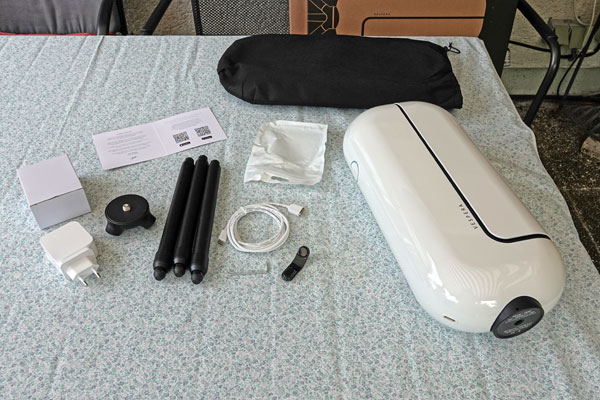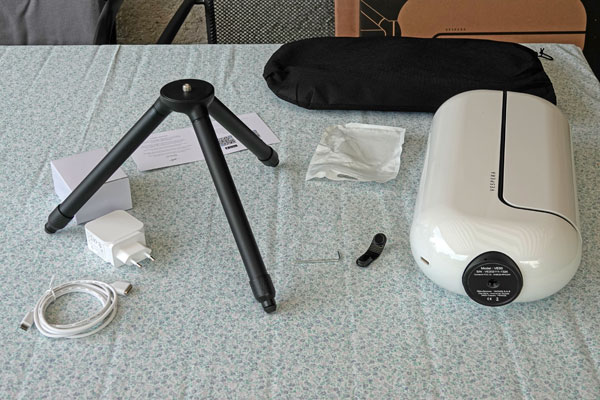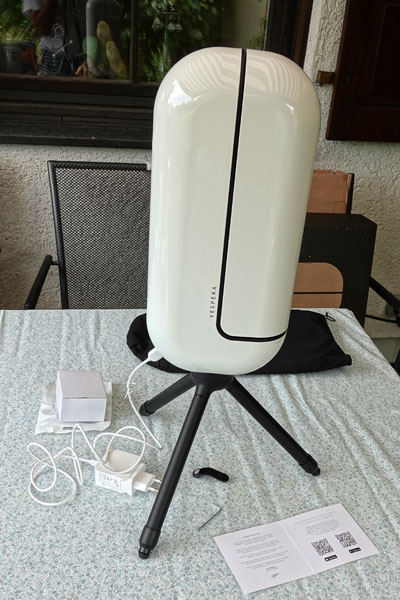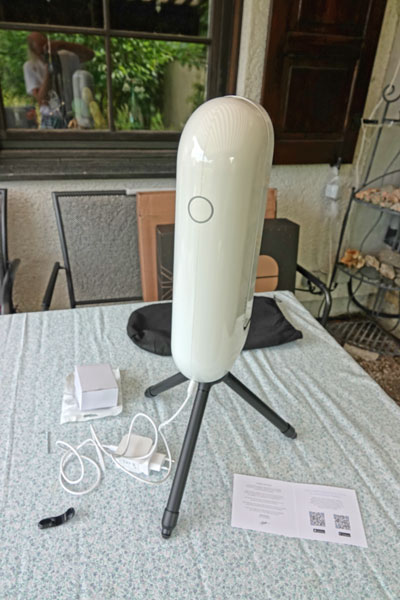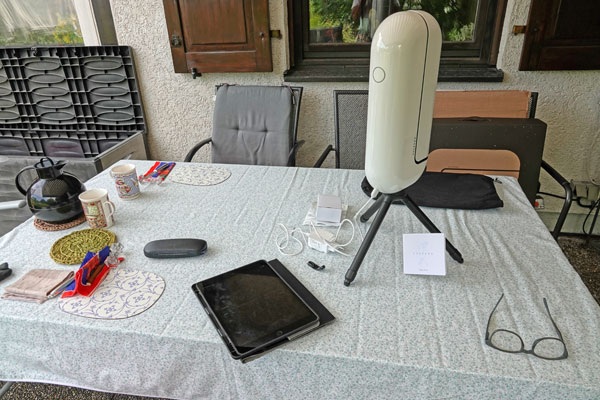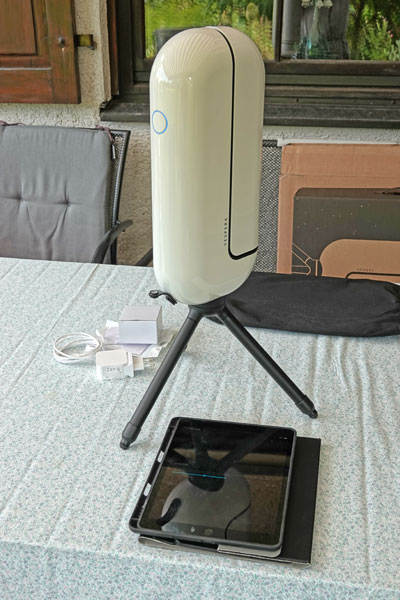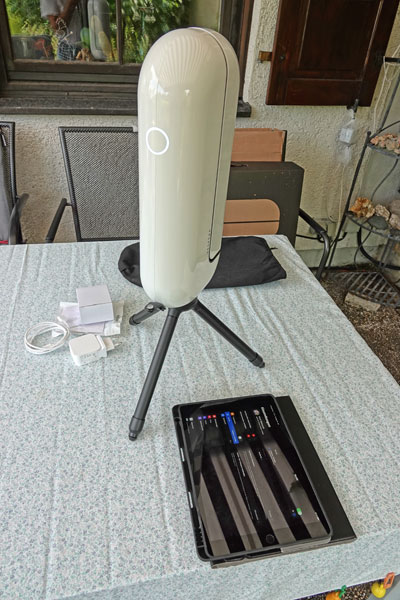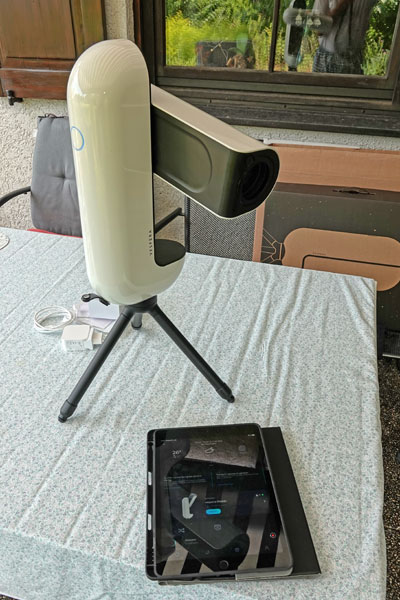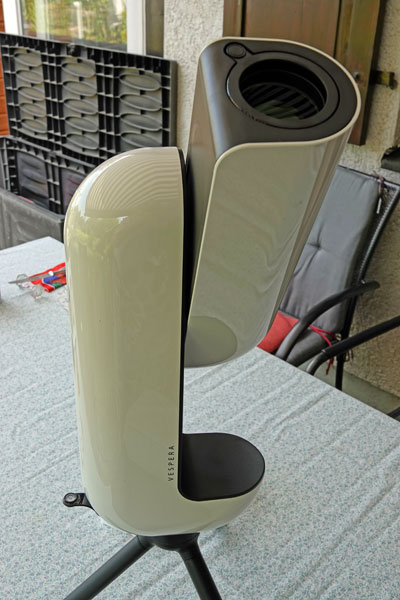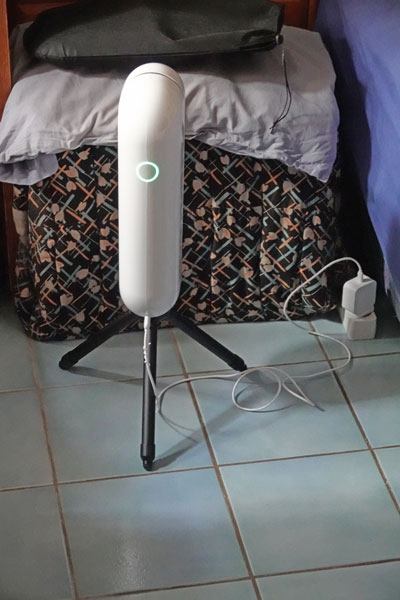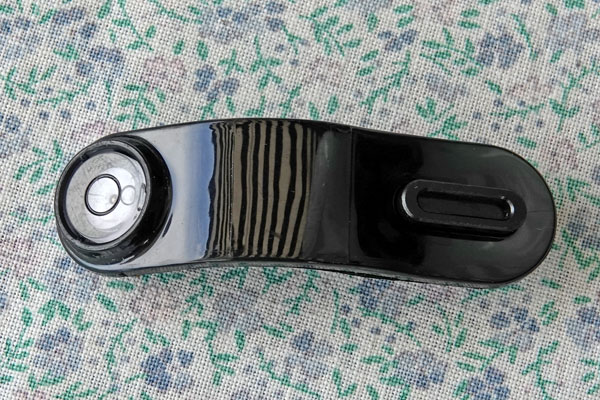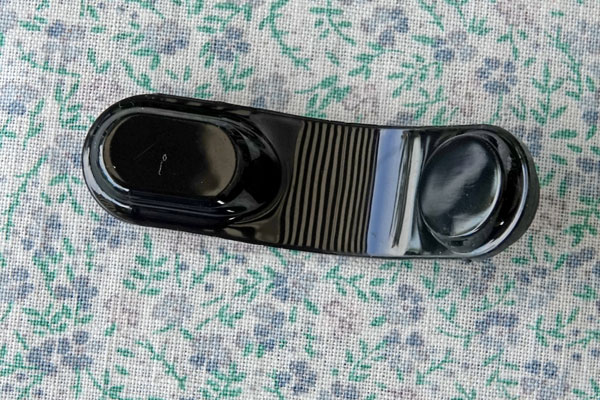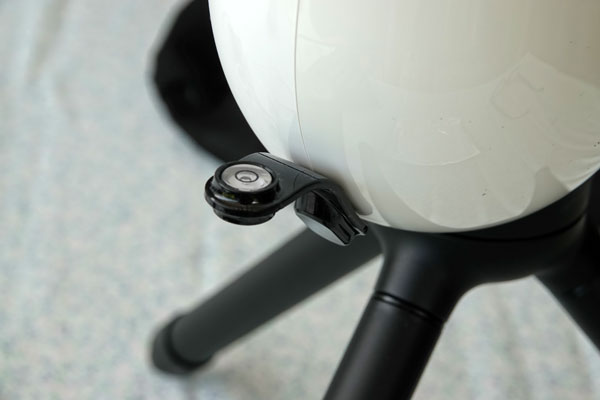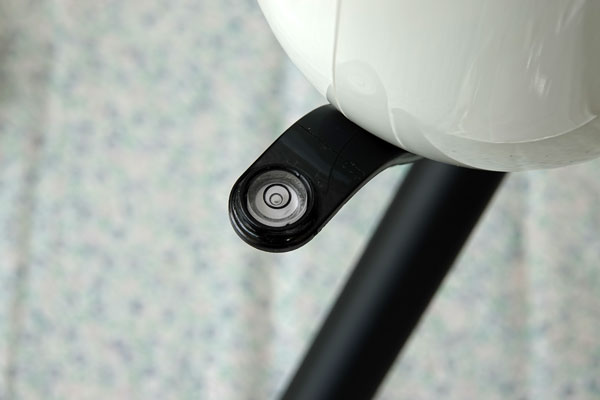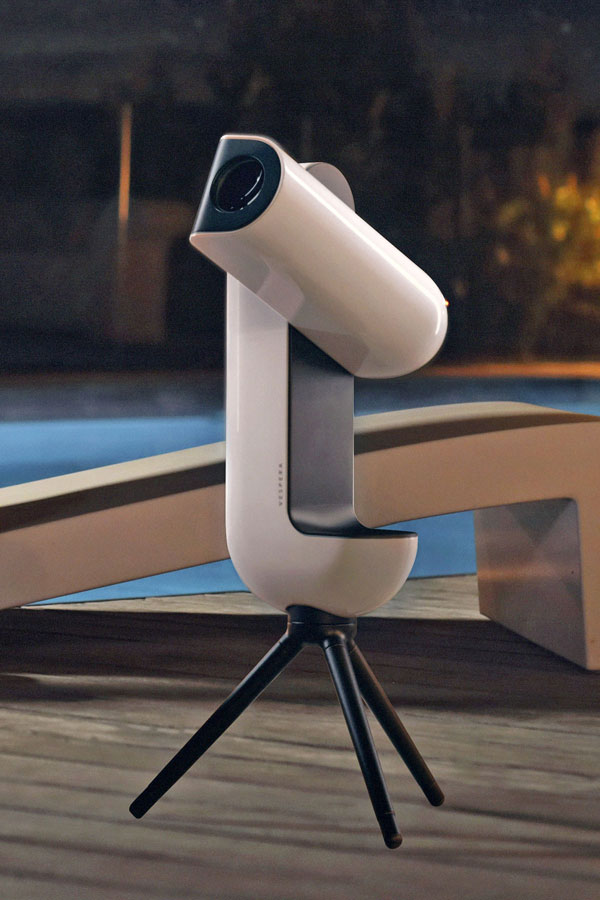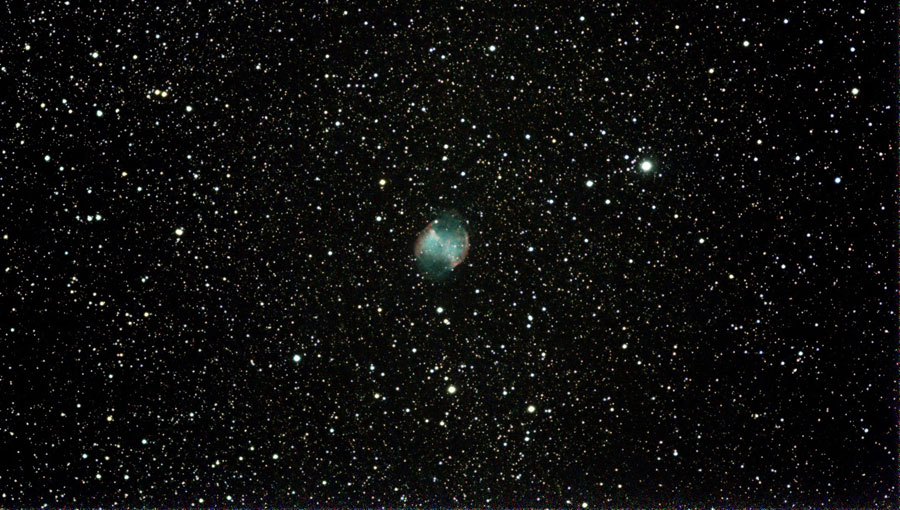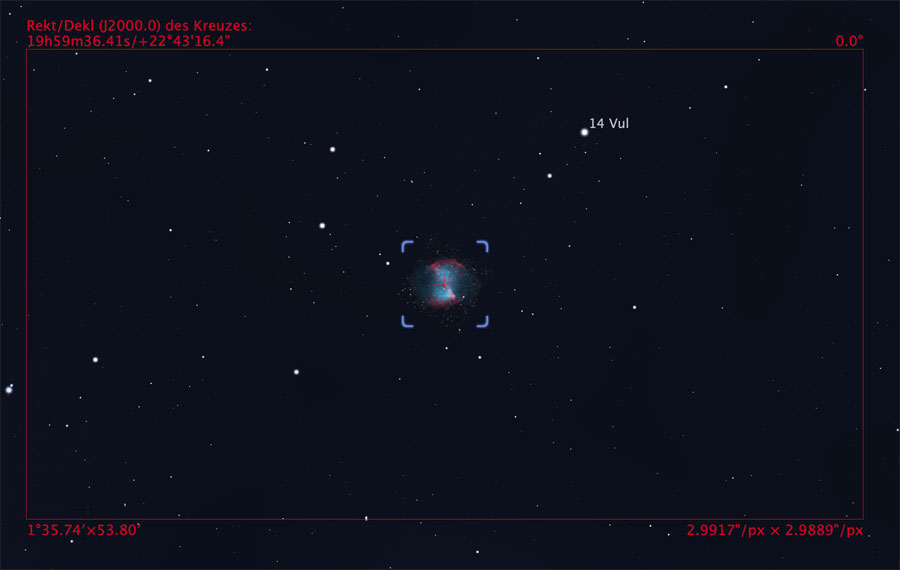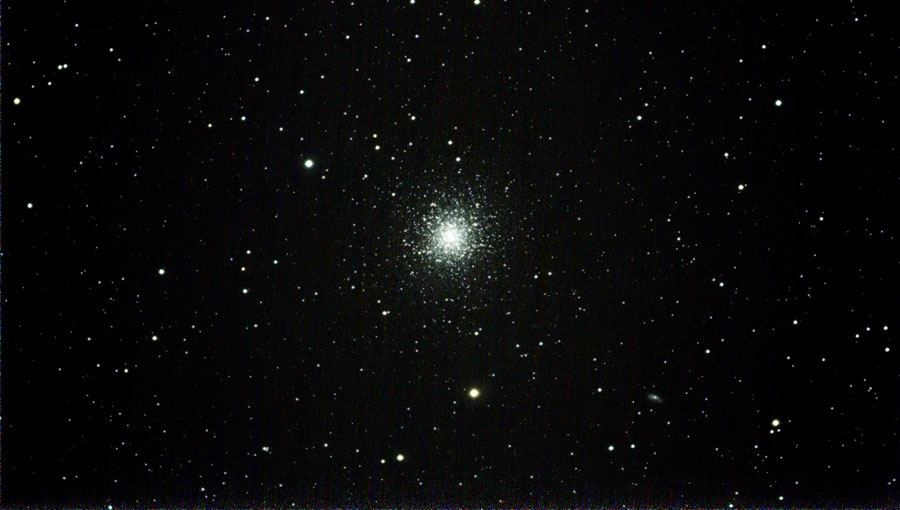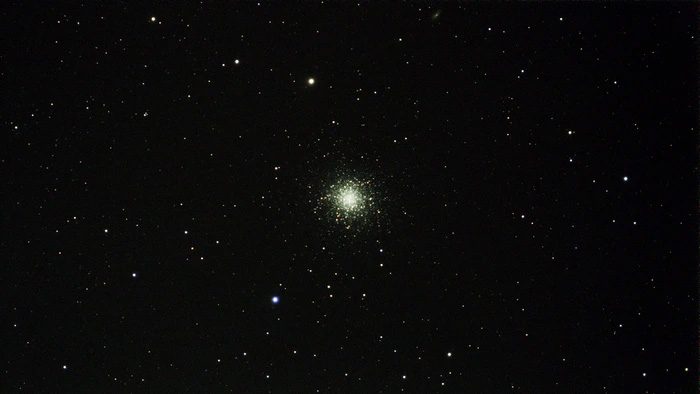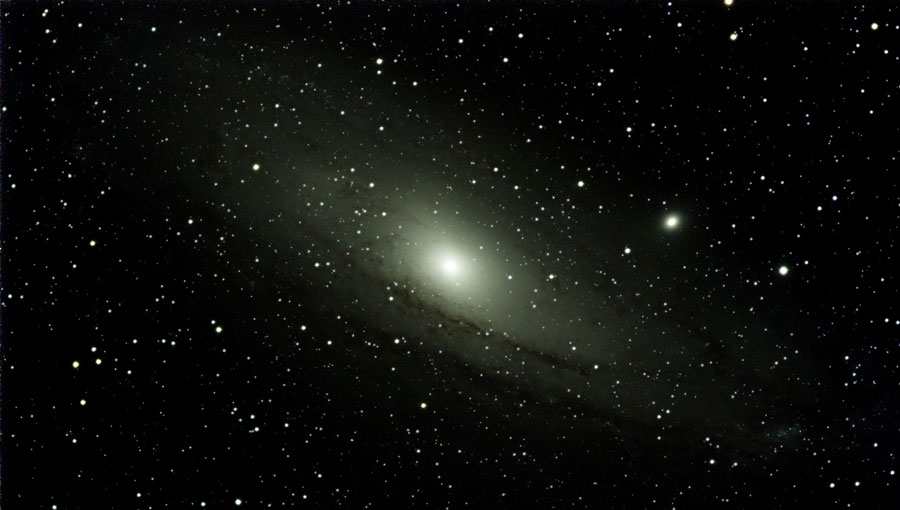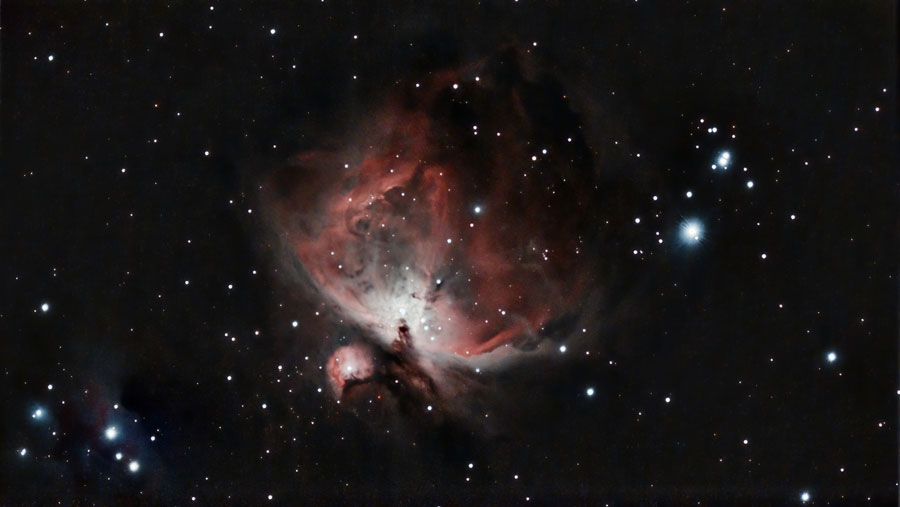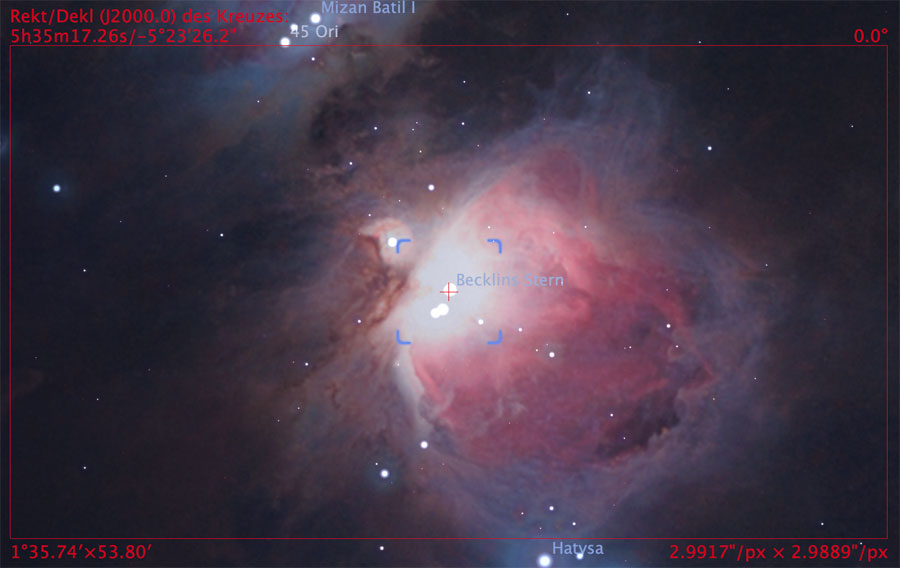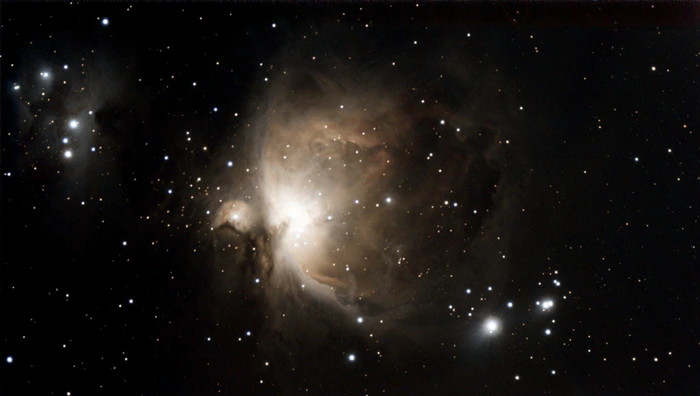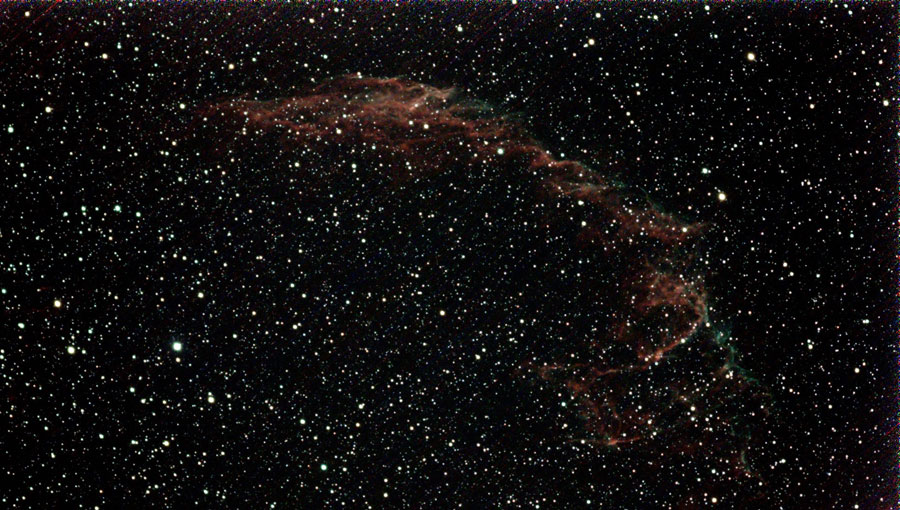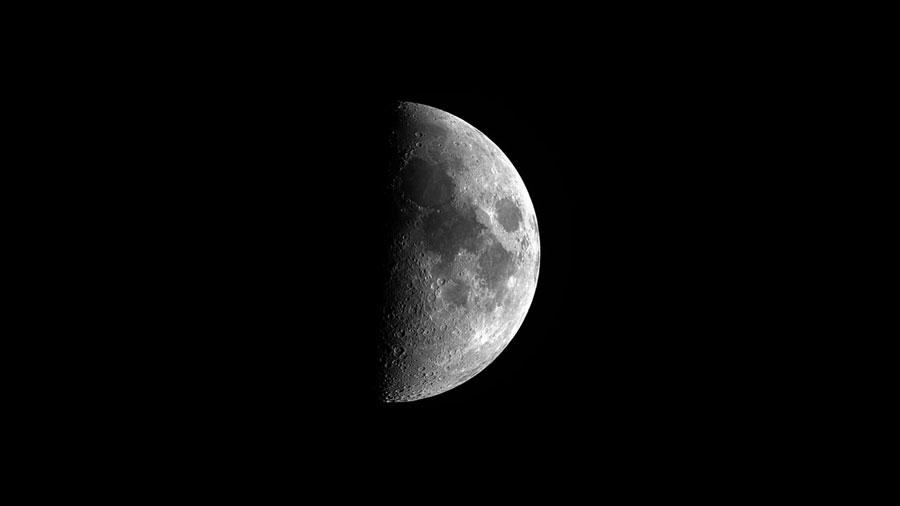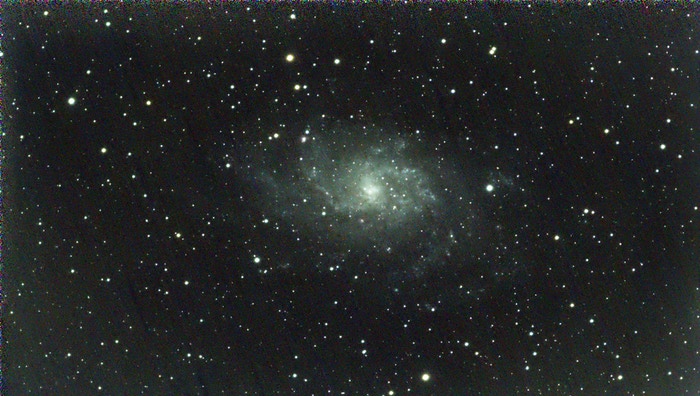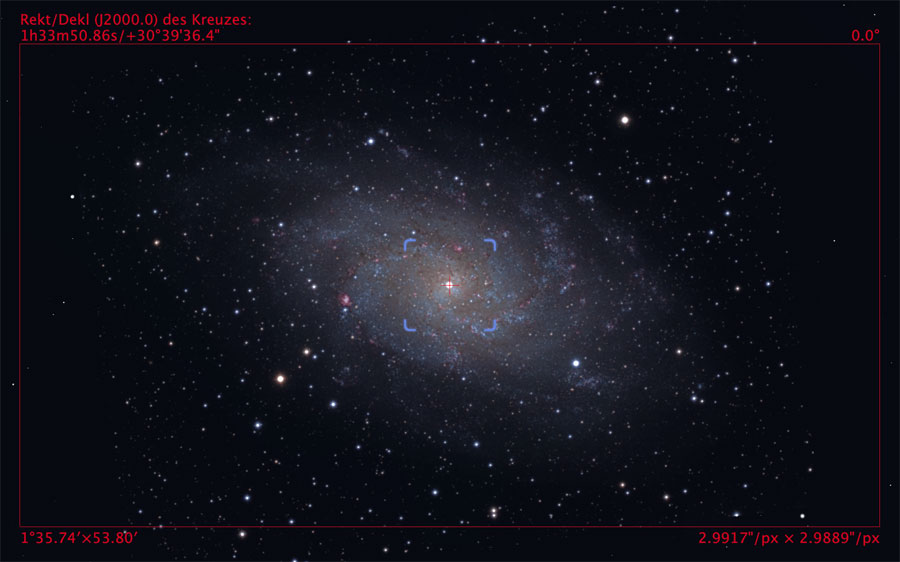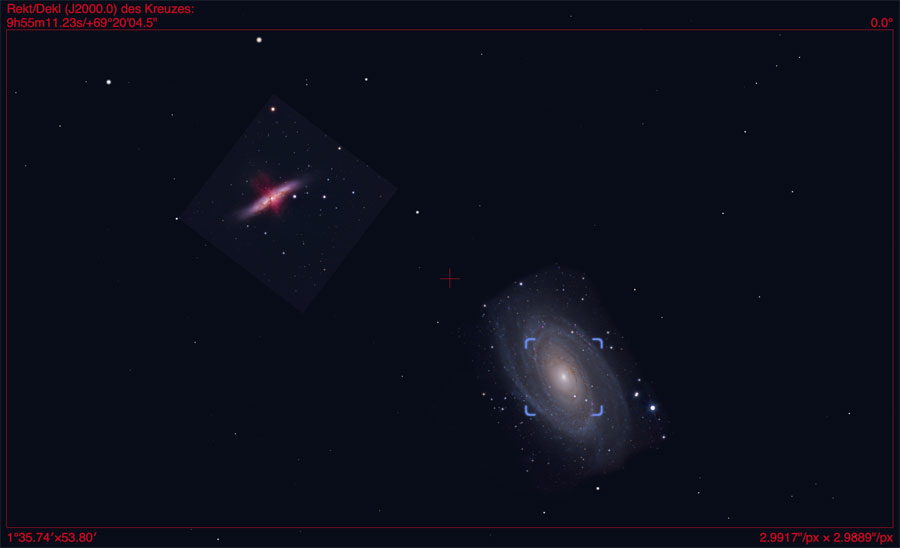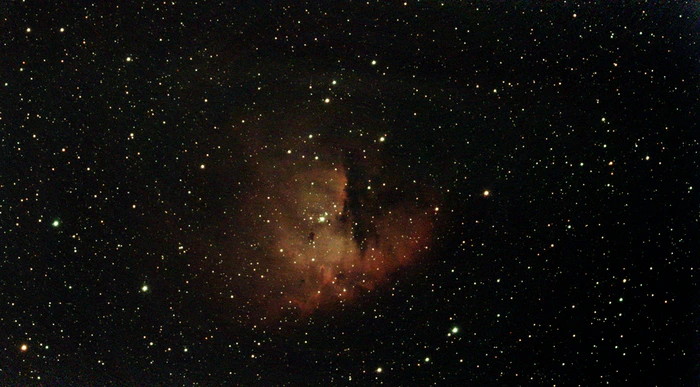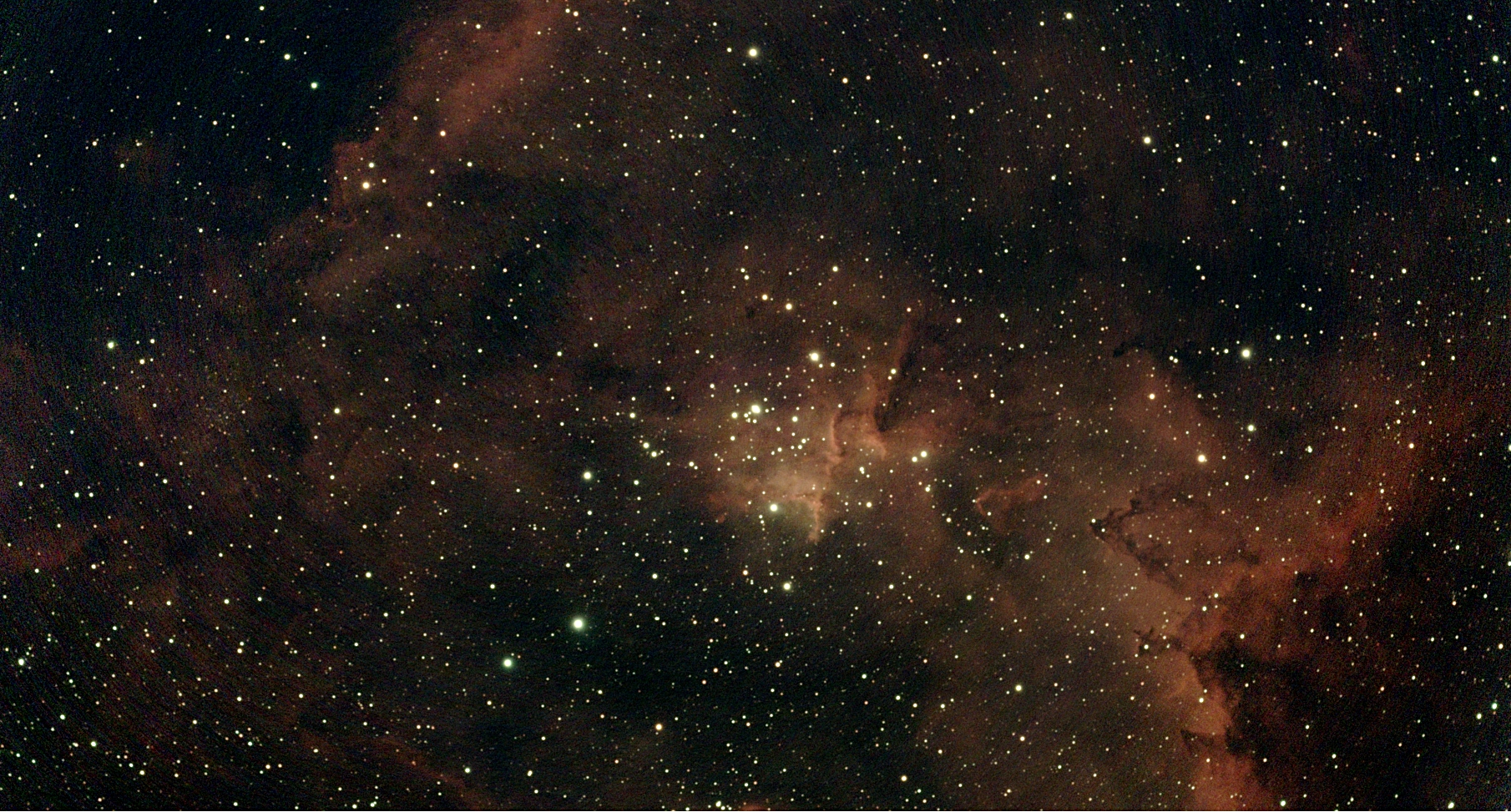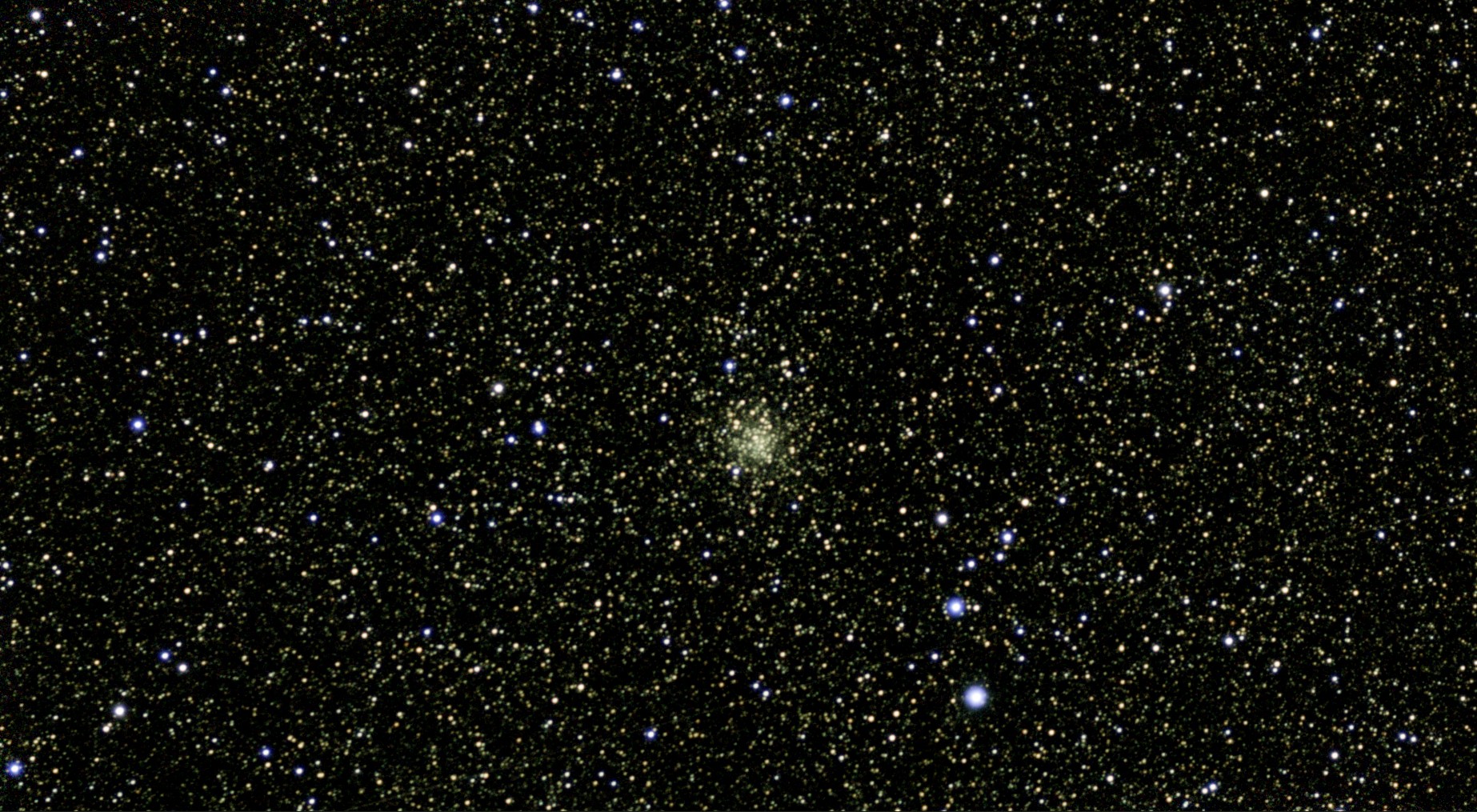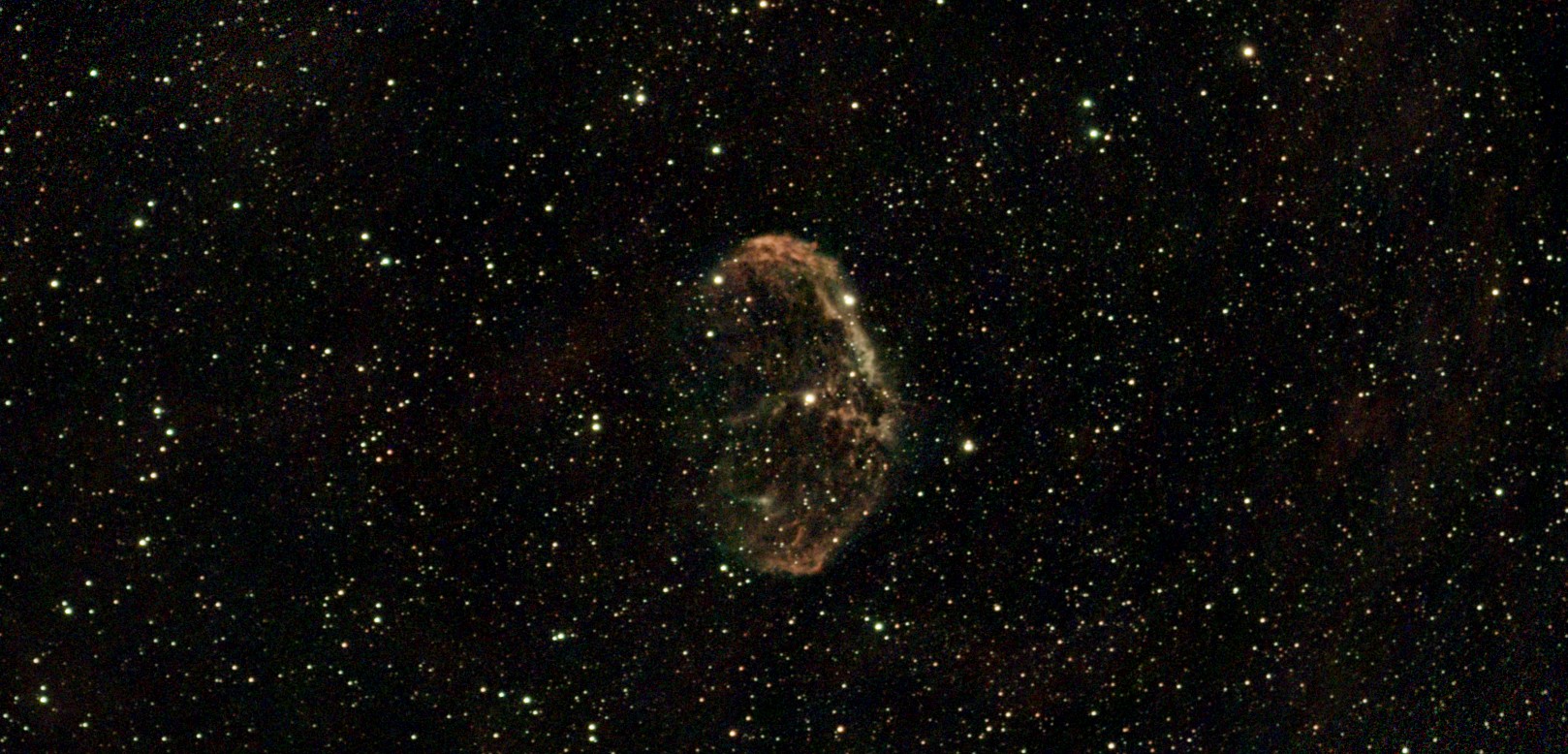Vaonis Vespera - Information (2" Refractor)
Introduction | About Vespera | Look | Sensor, Pixel Data, Field of View, Image Size (Pixels) | Visited Sky Objects | First Experiences and Photos | Photo Attempts | First Conclusions | Links || Appendix: Technical Data | Appendix: Comparison of the Vaonis Vespera, Vaonis Stellina, and the Unistellar eVscope | Appendix: First Thoughts (without Owning Vespera...) | Appendix: Look | Appendix Photos | Appendix: Project Schedule and Delivery
Archive
On this page, I provide some information about my electronic 2" refractor telescope Vaonis Vespera 50 mm/200 mm (f/4). I supported it in a Kickstarter campaign starting on October 1, 2020 on the very first day. The campaign closed successfully at the end of October 2020. Vaonis promised a delivery before Christmas 2021, provided everything would go well (which did not...). Initially, this page contained preliminary information and described the course of the project. After having received the Vespera telescope on July 29, 2022, and the second part of the Adventurer Pack (backpack, accessories) on September 15, 2022, I also include my very first impressions here (unboxing; without Adventurer Pack accessories). The accessories are presented on page Vaonis Vespera - Adventurer Pack and More Accessories. Experiences and more are published on separate pages.
Notes:
- See also page Vaonis Vespera - Adventurer Pack and More Accessories
- See also page Vaonis Vespera - FAQ
- See also page Vaonis Vespera - First Experiences
- See also page Vaonis Vespera - First Conclusions (after about half a year)
- For a comparison with similar products, see page DSO Photography for Dummies - Motivation and Introduction.
- See also the Vespera product page on the Vaonis Website.
- Some of the photos were taken from the Vaonis Website. Vaonis granted me the permission to use their photos on my Website.
Note: In June 2024, I sold my Vaonis Vespera smart telescope. I therefore cannot report any further experiences with it here. |
Introduction
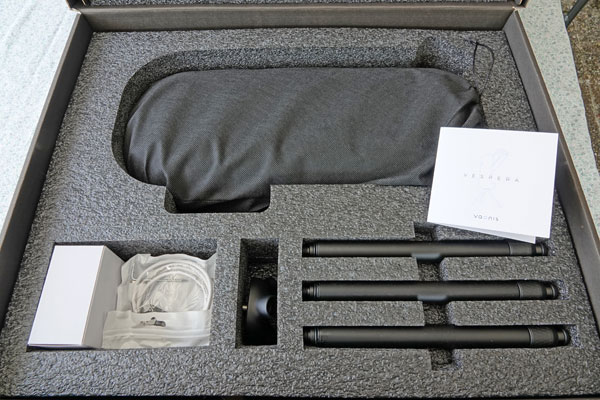 |
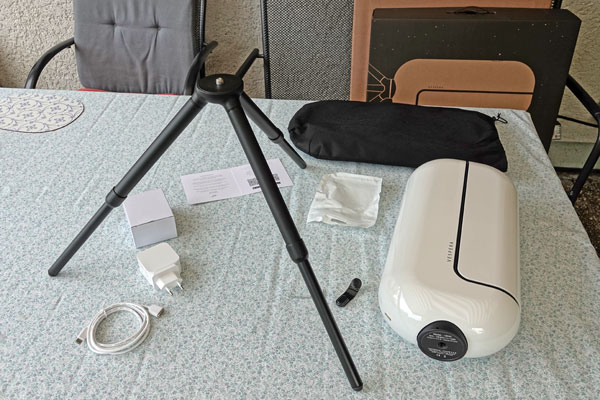 |
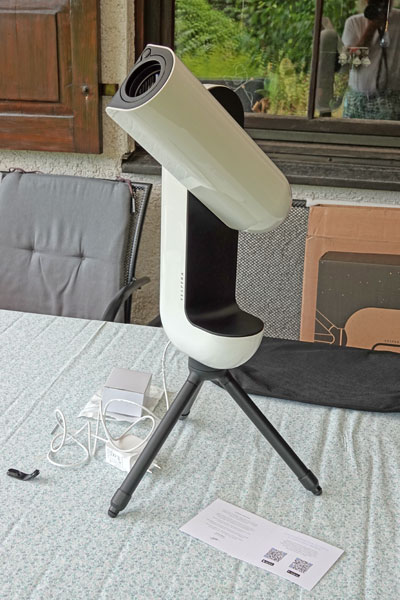 |
Photo: My Vaonis Vespera (end of July 2022)
Vespera is the second telescope that the French company Vaonis develops. For this purpose, Vaonis started a Kickstarter campaign on October 1, 2020, which I backed very early to get an early-bird offer - and I succeeded. I learned about this campaign because Vaonis contacted me personally. The campaign ended successfully at October 31, 2020 (2,163 backers, 2,559,952 $, even a little more successfully then eVscope with 2,144 backers and 2,209,270 $). Since the funding goal was reached, the development of the telescope could go on (see the project schedule below), until finally the mass production began. Delivery of the telescope was scheduled for Christmas 2021.
Around Christmas 2020, Vaonis sent, as a promised "goodie", some stickers to the Vespera backers:
Between the end of January 2021 and August 2022, Vaonis offered Vespera on its Website for a "pre-order" price of 1499 EUR (European price + 50 EUR shipping; delivery scheduled for the second half of 2022). From September 2022 on, the Vespera did costs 2499 EUR; it is also sold via astronomy dealers. In summer 2023, the price dropped to 1499 EUR again...
In a project update from Nov 8, 2021, the delivery of Vespera was postponed, only 400 "Basic" versions were delivered to the USA at the end of 2021. My version ("Adventurer") was not be delivered in Europe until the second quarter of 2022. In reality, however, I had to wait until July 29, 2022 for the Vespera and until September 15, 2022 for the accessories (Adventurer Pack).
Also the new Singularity app was announced, which replaced Stellinap. Furthermore, the standard tripod has been replaced by a hygrometer in package versions that also include the extended tripod (see below):
Replacement of the standard tripod by a hygrometer sensor (from Vaonis Newsletter, November 8, 2021)
Finally, we have decided to replace in all packs (except Classic Edition) the standard tripod with the hygrometer sensor we showed you in the previous update. Indeed, the high tripod (or more precisely the “adjustable height tripod”), which comes in the packs “Adventurer”, “Expert” and “Astronaut”, would duplicate with the standard tripod, because closed, the two tripods do the same size (only 1cm difference). The advantage of the adjustable tripod is that it allows you an extra 13cm of height when the legs are open and makes it easier to level on uneven floors. In summary, the Adventurer Packs will contain the following accessories:
ADVENTURER REWARD PACK
- 1 Vespera
- 1 Backpack
- 1 External battery
- 1 Hygrometer sensor (instead of standard tripod)
- 1 Adjustable tripod
Replacement of the external battery by a light pollution filter (from Vaonis Newsletter, June 20, 2022)
A few days ago, we learned of the blockage of external batteries that were about to be air freighted in for the Adventurer accessory packs. This is the result of legislation around the transport of lithium batteries (sold alone, not integrated into a product) getting tougher every month, all over the world. After exchanges with our logistician, we opted for a solution which seemed to us the simplest, fastest and best for you: send an accessory that brings even more benefits to your user experience. Consequently, all the additional batteries in the Adventurer, Expert and Astronaut packs will now be replaced by the light pollution filter. In summary, the Adventurer packs will contain the following accessories (will be sent in two steps):
ADVENTURER REWARD PACK
- 1 Vespera
- 1 Backpack
- 1 Light pollution filter (instead of external battery)
- 1 Hygrometer sensor (instead of standard tripod)
- 1 Adjustable tripod
Details on the telescope can be found further down! The Adventurer Pack und further accesories are presented on a separate page.
A Look at the Standard and the Adjustable Tripod (December 10, 2021)
Photos: The adjustable tripod (top), and both tripods (bottom) (from Vaonis Kickstarter page (EN); permission for use granted)
About Vespera
What is Vespera?
Vespera was meant to become a small and affordable version of Stellina. It is also a refractor, but a quadruplet with 50 mm aperture (like binoculars) and 200 mm focal length (aperture ratio f/4). It uses a Sony IMX462 Starvis sensor with HD resolution (1920 x 1080 pixels). This delivers a field of view of 1.6° x 0.9°, which makes the Vespera a small rich field telescope. Its image scale of 2.99 is quite high and leads to undersampling, but according to Astronomy.tools, this is acceptable for rich-field telescopes. With a weight of 5 kg and a height of 40 cm, the telescope is light and compact, making it an ideal travel telescope. The internal battery lasts for 4 hours, which is enough for me at least. I decided to go for the "Adventurer" package with a backpack, an additional battery, and an additional adjustable tripod (the simple tripod was replaced with a hygrometer sensor, the battery with a light pollution filter).
Price: During the Kickstarter campaign, the telescope alone had a price of 999 EUR. Between the end of January 2021 and August 2022, Vaonis offered Vespera on its Website for a "pre-order" price of 1499 EUR (European price + 50 EUR shipping; delivery scheduled for spring to summer 2022). From September 2022 on, the Vespera did cost 2499 EUR (European price + 50 EUR shipping); it is also sold via dealers. In summer 2023, the price dropped to 1499 EUR again...
Here are some technical data:
Technique |
Optics |
Mount |
||
|
Sensor
|
Other
|
More about this telescope on page Vaonis Vespera: The new way to observe the universe (Kickstarter). Vaonis also compiled an FAQ for this telescope early on: support.vaonis.com/portal/en/kb/faq/vespera (EN)
Why Did I Opt for the Vaonis Vespera?
As the saying goes: Half she pulled him, half he fell down. In the end, it was a mixture of curiosity and "supposed need." I was already flirting a little bit with the Stellina, but then I had already decided on the eVscope and backed it in a Kickstarter campaign. And the Stellina became more and more expensive. Later, I learned from tests that the Stellina exposes much longer than the eVscope, where often a few minutes are enough for a proper photo. I can therefore observe many more objects with the eVscpe in one evening than with the Stellina. I was actually quite happy that I had decided for the eVscope, even though the Stellina is clearly ahead in terms of image quality.
Vespera attracted me because of its wide field of view, which is 1.5° wide horizontally. Thus, the Vespera is almost a "rich-field" telescope and complements the eVscope well, which only offers a field of view of 0.5°. In addition, Vaonis states that the Vespera achieves good results in about 5 minutes (but for achieving very good results, it will probably take half an hour to an hour...). Of course, I was also attracted by the completely different technique of the Vespera, especially the comparison between a lenticular and a Newtonian telescope. And last, but not least, the much lower price of the Vespera, also thanks to the Kickstarter campaign, which did not exist for the Stellina, also played a role in the decision...
Of course, the Stellina does a lot of things better than the Vespera, but that should not surprise considering the price difference. A table comparing the Vaonis Vespera and the Vaonis Stellina can be found in the appendix. I took this information with slight modifications from the Vaonis Website. In the appendix, I also present some initial thoughts about the Vespera (and its competitors) without owning the Vespera...
Who is Behind the Vaonis Vespera?
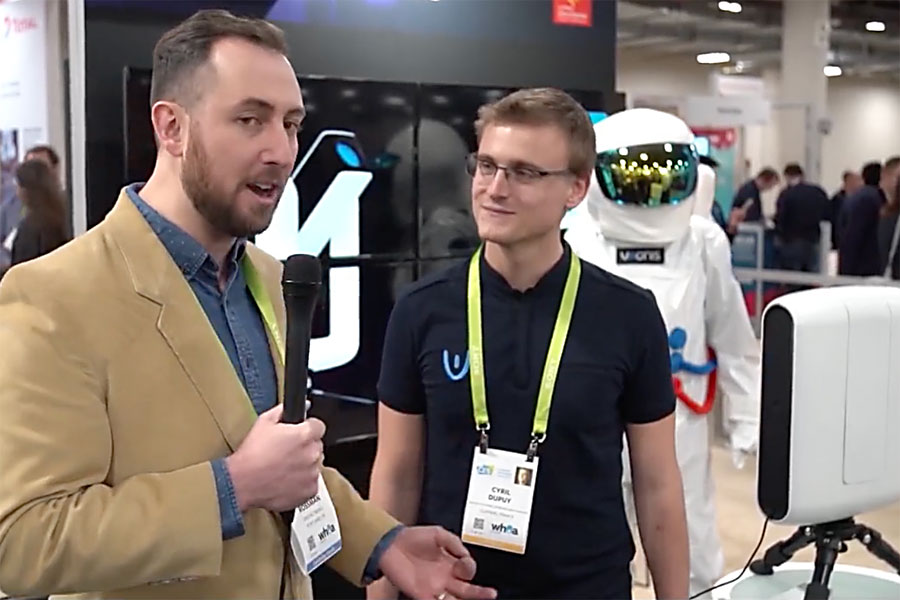 |
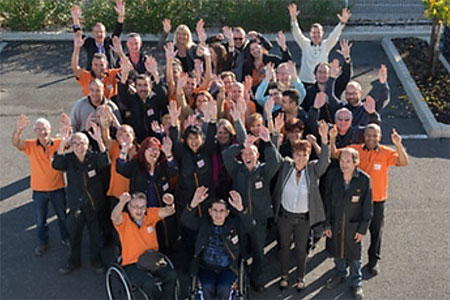 |
|
Cyril Dupuy, founder and CEO of Vaonis, in an interview |
The manufacturer's team |
(Photos from the Vaonis-Website (EN); permission for use granted)
Vaonis is a French company based in Montpellier, France, that designs and manufactures telescopes and accessories. The company was founded in 2016 by Cyril Dupuy, a young start-up entrepreneur, after obtaining his Bachelor in Optics and Aerospace. From his experience of using different telescopes with complex installation, long user guides and recurring breakdowns, he imagined and designed Stellina, the world's first all-in-one telescope connected to a mobile app. Vaonis' products are designed and developed by specialists in optics, mechanics, electronics, material and ergonomics, giving special attention to its design, quality and safety. (From the Vaonis Website, adapted)
Look (Aventurer Pack, Part 1)
Here I present photos of the unboxing, the telescope itself, and its first accessories (tripod, power supply). See also page Vaonis Vespera - Adventurer Pack and More Accessories for further accessories.
Sensor, Pixel Data, Field of View, Image Size (Pixels)
The Vespera uses the sensor Sony IMX462 (CMOS), with a used pixel size of about 2 megapixels, or 1920 x 1080 pixels (H/V). The pixel size is 2.9µm (quadratic pixels).
With this, all sizes are known to calculate the field of view of the Vespera, which amounts to 1.6° x 0.9°.
The following table shows the Vespera, eVscope, and eVscope 2 in comparison with my current telescope tubes at a selection of cameras that I own(ed):
Field of View |
IS* | |||||||||
| Telescope | Reducer | Focal Length |
Aperture | f | ASI224MC* | ASI294MC | ASI462MC* | Atik Infinity* | Remarks | |
| PS 72/432 | --- | 432 | 72 | 7 | 0.65° x 0.48° | 2.54° x 1.73° | 0.74° x 0.42° | 1.19° x 0.89° | The largest FOV of my tubes | |
| C5 | --- | 1250 | 127 | 10 | 0.22° x 0.17° | 0.88° x 0.60° | 0.26° x 0.15° | 0.41° x 0.31° | FOV like C8 with reducer | |
| C5 | f/6.3 | 787.5 | 127 | 6.3 | 0.36° x 0.17° | 1.40° x 0.95° | 0.41° x 0.23° | 0.65° x 0.49° | FOV a little smaller as with TLAPO1027 | |
| C8* | --- | 2032 | 203 | 10 | 0.14° x 0.1° | 0.54° x 0.37° | 0.16° x 0.09° | 0.25° x 0.19° | The smallest FOV | |
| C8* | f/6.3 | 1280 | 203 | 6.3 | 0.22° x 0.16° | 0.86° x 0.58° | 0.25° x 0.14° | 0.4° x 0.3° | FOV like C5 | |
| TLAPO1027* | --- | 714 | 102 | 7 | 0.39° x 0.29° | 1.54° x 1.05° | 0.45° x 0.26° | 0.72° x 0.54° | FOV a little larger than for C5 with reducer | |
| in Degrees | in Minutes | |||||||||
| eVscope* | --- | 450 | 114 | 4 | 0.61° x 0.46° | 36.7' x 27.6' | 1.72 | Same sensor as ASI224: Sony IMX224 | ||
| eVscope 2* | --- | 450 | 114 | 4 | 0.78° x 0.57° | 47' x 34' | 1.33 | New sensor: Sony IMX347 | ||
| Vespera* | 200 | 50 | 5 | 1.6° x 0.9° | 96' x 54' (ca.) | 2.99 | Same sensor as ASI462: Sony IMX462 | |||
| Vespera Pro | 250 | 50 | 5 | 1.6° x 1.6° | 96' x 96' (ca.) | 1.65 | New sensor: Sony IMX676 | |||
*) No longer in my possession
*) IS = image scale: describes the relative sizes of objects at 1:1 pixels (the larger the number, the smaller the objects)
All in all, the Vespera (Pro) offers the widest FOV of all the telescopes or telescope camera combinations listed here, except for the ASI294 at the PS 72/432. And the TLAPO1027 delivers about the same FOV with the ASI294MC as the Vespera. The FOV of the C5 with reducer/corrector and ASI294MC is also almost as large.
Field of View in Mosaic Mode
Summary of mosaic characteristics for the Vespera (from the CovalENS article):
- Native field of view of the telescope: 1.6° x 0.9°
- Extended field max. size (sensor ratio): 3.2° x 1.8°
- Extended field max. size (square): 2.4° x 2.4°
- Extended field max. size (horizontal): 3.6° x 1.6°
- Extended field max. size (vertical): 0.9° x 6.4°
- Extended field max. definition (file size): 8.2 Mpx
Image Size (Pixels)
Sony's IMX462 sensor can be used with 1920 x 1080 pixels, and this is what Vaonis opted for for the Vespera. However, the photos are often somewhat smaller because they are automatically cropped, probably in response to field rotation.
Visited Sky Objects
Here I list the deep sky objects that I observed and photographed initially with the Vaonis Vespera:
- July 29, 2022: M 13, M 16, M 27, M 51, M 82, M 92, M 101
- July 30, 2022: M 10, M 12, M 13, M 14, M 57, M 81
- July 31, 2022: M 3, M 5, M 11, M 13, M 16, M 17, M 27, M 56, M 71, M 81/82, NGC 6960, NGC 6992, NGC 7000, IC 1396 (not recognized)
- August 4, 2022: M 51, 13, M 51, M 27
- August 6, 2022: M 13, M 3, M 5, NGC 6633, M 27, (M 29), (M 39), M 16, M 51, (NGC 7000)
- August 7, 2022: Cr 399, (M 16), M 51, M 101
- August 12, 2022: M 13, M 82, M 81/82, M 31, M 32, NGC 884/869, NGC 7789, NGC 6960, M 27, NGC 6992, NGC 457
Only in rare cases, I followed the Vaonis recommendation for the observation time. You can see the images taken on page Vaonis Vespera - First Experiences. All observed DSO can be found on page My Deep Sky Observations with the Vespera (Complete List of Observed DSO).
First Experiences and Photos
On page Vaonis Vespera - First Experiences, I describe my very first experiences with the Vaonis Vespera. For space reasons, I created a new page for this. This page also presents my photos of the objects that I list in "Visited Sky Objects" above (my very first observations with Vespera).
First Conclusions
After a little more than half a year with the Vaonis Vespera (end of February 2023), I would like to attempt first conclusions. First of all, I am happy to have "jumped on the Vespera bandwagon" and to have purchased the Vespera at a significantly lower price during the Kickstarter campaign. Second, my judgment is inevitably influenced by what I have experienced with the original Unistellar eVscope and the eVscope 2. And so, in these first conclusions, I will keep making comparisons with the eVscope (2).
For space reasons, I also moved the first conclusion to its own page First Conclusions.
Conclusion from there...
I am happy to have purchased the Vaonis Vespera and to be able to record photos in better quality than with the eVscope. However, I still have to get used to the slower observing speed... Maybe it would be a good idea to build up a visual telescope in parallel to better usilize the observation time (and also the visual telescope).
Note: In June 2024, I sold my Vaonis Vespera smart telescope. I therefore cannot report any further experiences with it here. |
Links
- Vaonis: vaonis.com/fr (FR), vaonis.com (EN)
- Vespera Kickstarter campaign: www.kickstarter.com/projects/vaonis/vespera-the-new-way-to-observe-the-universe/description
- Vespera/Stellina comparison page: vaonis.com/stellina-vs-vespera (EN)
- Vespera FAQ: support.vaonis.com/portal/en/kb/faq/vespera (EN)
- See also my page offering Astronomy Links.
Appendix: Technical Data for the Vaonis Vespera
Hardware
- Magnification: 33 x optical
- Maximum magnitude: up to 13 mag in good sky
- Aperture: 50 mm
- Focal length: 200 mm
- Focal ratio: 1:4
- Motorized Alt-AZ mount
- Weight: 5 kg
- Size: 15 x 8 x 3.5 in (40 x 20 x 9 cm)
Bag
- See photo further down
Electronics
- Sensor model: Sony IMX462 (CMOS) - for details see further below
- Battery life: up to 4 hours (internal battery)
- Wireless connectivity: Wifi for smartphone or computer control and GPS access (no GPS inside)
Smarts
- Autonomous field detection
- Fully automated star alignment procedure
- Automated pointing
- Automated celestial tracking
- Intelligent image processing
Sensor Data
- Sony Starvis IMX462 color CMOS sensor - 2.1 MPixels
- Sensor size: 1/2.8" diagonal* (4.8 mm x 3.6 mm), 1920 x 1080 pixels
- Pixel size: 2.9µm x 2.9µm
- Read noise: < 0.5e-
Appendix: Comparison of the Vaonis Vespera, Vaonis Stellina, and the Unistellar eVscope
Source: vaonis.com/stellina-vs-vespera#Diff
| Vespera | Stellina | eVscope | eVscope 2 | |
| Weight | 5 kg (11 lbs) | 11.2 kg (24.7 lbs) | 9 kg (19.8 lbs) including tripod |
9 kg (19.8 lbs) including tripod |
| Height | 40 cm (15 in) | 49 cm (19 in) | 65 cm (25.5 in) | 65 cm (25.5 in) |
| Width | 20 cm (8 in) | 39 cm (15 in) | 23 cm (9 in) | 23 cm (9 in) |
| Depth | 9 cm (3.5 in) | 13 cm (4.7 in) | n.a. | n.a. |
| Telescope type | Refractor | Refractor | Reflector (Newtonian) | Reflector (Newtonian) |
| Lens/Mirror | Apochromatic Quadruplet | Apochromatic Doublet | mirror | mirror |
| Lens/Mirror special features | Extra low dispersion S-FPL52 equivalent (ULD) with lanthanum glass | Very low dispersion S-FPL51 equivalent (ED) with lanthanum glass | BK7 glass mirror | BK7 glass mirror |
| Aperture | 50 mm | 80 mm | 112 or 114 mm | 112 or 114 mm |
| Focal length | 200 mm | 400 mm | 450 mm | 450 mm |
| Focal ratio | F/4 | F/5 | F/4 | F/4 |
| Field of view | 1.6° x 0.9° | 1° x 0.7° | 0.61° x 0.46° (36.7' x 27.6') | 0.78° x 0.57° (47' x 37') |
| Mount | Alt-azimuth | Alt-azimuth | Alt-azimuth | Alt-azimuth |
| Field derotator | no, done in software | yes | no, done in software | no, done in software |
| Image sensor | Sony IMX462 | Sony IMX178 | Sony IMX224 | Sony IMX347 |
| Resolution | 1920 x 1080 (2MP) | 3072 x 2080 (6,4MP) | 1280 x 960 (1,2 MP) / 2560 x 1920 (2,4 MP) scaled (EV mode) | 2048 x 1536 (3,2 MP), 3200 x 2400 (7,7 MP) scaled (EV mode) |
| Sensor size | 1/2.8" | 1/1.8" | 1/3" | 1/1.8" |
| File formats | JPEG, TIFF, FITS (TIFF/FITS in 16 bits) | JPEG, TIFF, FITS (TIFF/FITS in 16 bits) | PNG | PNG |
| USB port (pictures download) | no (with Wi-Fi) | yes | no (with Wi-Fi) | no (with Wi-Fi) |
| Autofocus | yes | yes | no | no |
| Light pollution filter | Optional | yes | no, done in software | no, done in software |
| Dew control | Yes as soon as the sensor is installed | yes | no | no |
| Temperature/humidity sensor | Optional | yes | no | no |
| Battery type | Integrated | External (powerbank) | Integrated | Integrated |
| Battery life | up to 8 h | up to 5 h | up to 10 h | up to 10 h |
| Water resistance | IP43 | IP53 | n.a. | n.a. |
| Multi user mode | up to 5 users* | up to 10 users | yes (number unknown) | yes (up to 10 users) |
| Number of objects in data base | 200 (October 2020) | 200 (October 2020) | > 5000, > 120 with descriptions | > 5000, > 120 with descriptions |
| Object access via coordinates | yes | yes | yes | yes |
| 2021/2022 Developments | ||||
| Solar pointing | yes (with optional filter) | yes (with optional filter) | yes (with optional filter) | yes (with optional filter) |
| Connected battery | possible | yes | possible | possible |
| Connection to Wi-Fi hotspots | no | yes | no | no |
| Scheduling of observations | up to 3 objects* | unlimited | no | no |
| Expert mode (camera control) | yes | yes | manual pre-processing (brightness, background) already available in 2020 | manual pre-processing (brightness, background) |
| HDR Image processing | yes | yes | no | no |
| Pictures stocking in the app | up to 200 MB | up to 200 MB | no, on the smartphone depending on its memory size | no, on the smartphone depending on its memory size |
| Mosaic mode | 3.2° x 1.8° (4 x sensor field) at maximum | 2.0° x 1.4° (4 x sensor field) at maximum | no | no |
*) Vaonis decided to open certain software features to Vespera as well; I will add the respective information as soon as I got it.
Appendix: First Thoughts (Without Owning Vespera...)
Above I explain why I opted for Vespera, even though I already own an eVscope. And why not the Stellina? Well, Stellina is without question the better telescope in all respects, except for size and weight, of course. But with its price of 4000 EUR it is simply beyond what I am willing to spend. My expensive telescopes (C8, TLAPO1027, eVscope) are all, depending on the device, with or without accessories just under 2000 EUR. So this seems to be my "pain limit". I will not allow myself any more to have the infamous 6000 EUR refractor, which is supposed to be the "measure of all things"... The are the "strong points" of Vespera for me: the comparatively low price (thanks to the Kickstarter campaign; but 20% VAT have to be added...), the large field of view, the combination of a small size and a low weight making Vespera suitable for travel and iat its image quality is noticeably better than that of the eVscope (although the objects are smaller, and it takes longer to create an image).
How Long Will It Take, until I Get a Satisfying Image with Vespera?
I note above that Stellina requires longer exposure times than the eVscope and that I am glad to own the eVscope because it allows me to visit many more sky objects during one observation session. I also noted this in the comments at Kickstarter and read different opinions about this. I downloaded the Stellina app and saw there that the recommended exposure times for Stellina typically range from 15 to 30, and up to 120 minutes. And the longer you observe, the better the image quality and the more colors and details appear, the comments say.
Cyril Dupuy, CEO of Vaonis, writes in the comments that Vespera compensates for its smaller aperture by using longer exposure times (which also applies to Stellina). But elsewhere I also found that Vespera already shows a picture after half a minute to 1 minute and should show nice pictures after about 5 minutes. And in a comment it was also written that for demonstrations for other observers it is enough to expose for 5 minutes (but for best pictures 1 to 2 hours...). Obviously, it is a question of personal taste how long you want to expose. This is also true for the eVscope, where you can stop after 1 to 2 minutes for many objects. In the end, I will only know more about this when I can compare Vespera and eVscope directly. But for the time being, I assume that you can observe faster with the eVscope, if that should be important to you...
Vespera and Extended Sky Objects
With its horizontal field of view of 1.6°, Vespera is almost a rich-field telescope and therefore suitable for observing larger sky objects. The whole thing has a little hook, though, which I do not know how large it is. The sensor has an aspect ratio of 16:9, so it delivers a "wide screen image" (which I do not like). An object such as the Andromeda galaxy (3° x 1°) fits quite well into this field of view - but only if both, sensor and galaxy, are aligned the same way. But that is probably rather rarely the case! With a normal astronomy camera, you can turn the camera in such a case until the axes are aligned. With Vespera, however, this is not possible - the sensor cannot be turned.
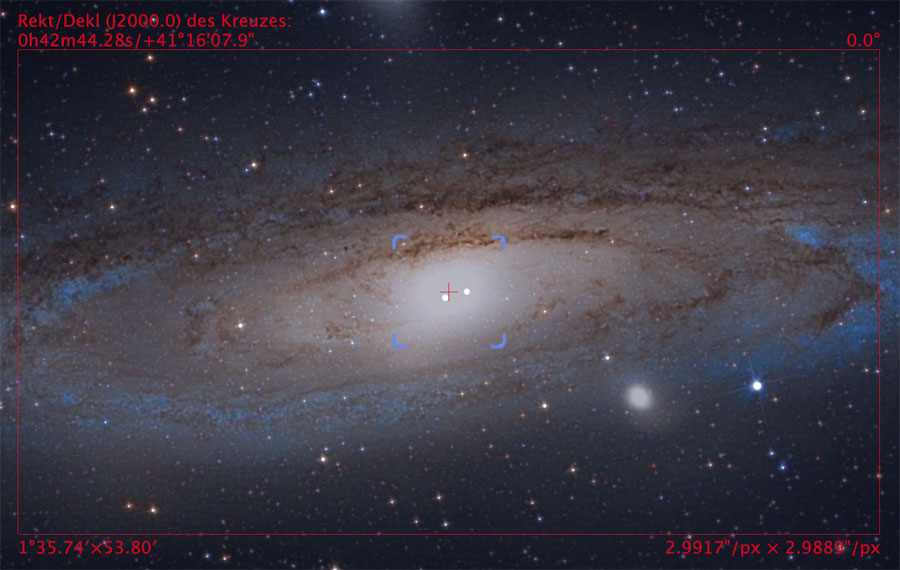 |
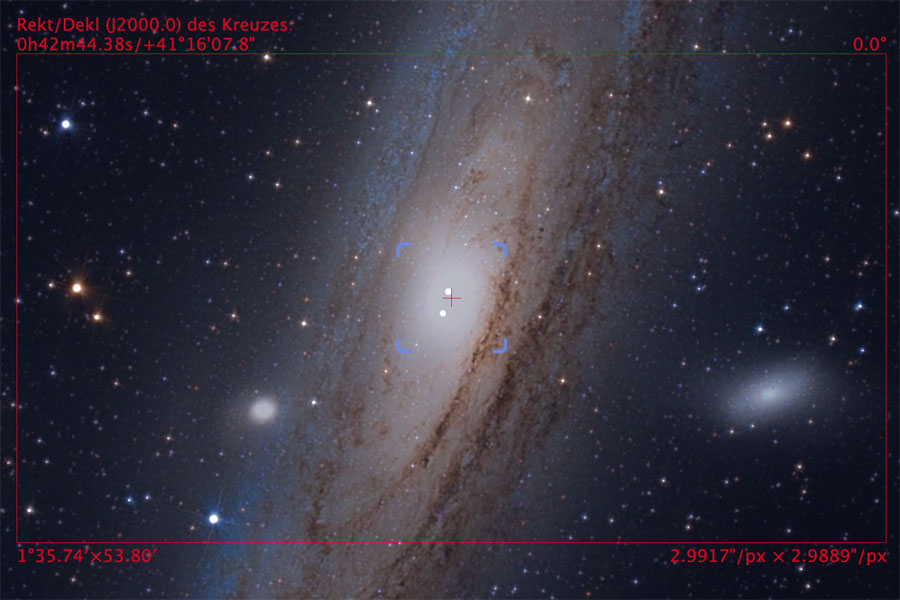 |
|
M 31 in Stellarium with FOV of Vespera - here the axes are aligned |
M 31 in Stellarium with FOV of Vespera - here the alignment does not fit, but M 110 is now in the FOV... |
What can you do? One possibility is to wait for a season or time when both main axes are aligned in the same way. Vaonis gave another recommendation in the Kickstarter comments: Use the mosaic mode! This might be a solution, but it multiplies the time needed for a photo and thus, sets higher demands on the weather. Instead of one hour, the sky needs to stay clear for many hours. Maybe, Vaonis should offer a simple 2:1 mosaic mode consisting of just two photos on top of each other to alleviate this problem (1.6 x 1.8° or a little less vertically, because of some overlapping)...
Update: The Vespera Pro will offer a field of view of 1.6° x 1.6° (delivery scheduled for May 2024).
Do I Need the Forthcoming Filters?
The following filters will be offered for Vespera: Sun filter (ND), CLS (light pollution), Hydrogen-Alpha, Oxygen-III and Sulphur-II. I did not choose a reward with filters because I wanted to save the money in the first place, and I rarely use filters. And I dare to doubt whether a sun filter is useful at Vespera, because the sun does not get very large with it (see the moon photo). For this purpose, I will rather use other telescopes for which I already own solar filters.
I did not even know what the Hydrogen Alpha, Oxygen III, and Sulphur II filters are actually good for, I haved to read up on that first (these are narrow band filters for gas and planetary nebulae). And the colors might get false, as well... Probably, the light pollution filter would be the best choice for me. But I think I will start without any filters for now...
Update: In June 2022, Vaonis announced that in packages that include an external battery, this will be replaced by a light pollution filter. So, since I ordered an Adventurer Pack, I will receive such a filter.
Do I Need the External Heating to Prevent Dew?
For years, I have observed without having any dew problems, which may have been due to the observation times and the used telescopes, mostly Newtons. Only in the year 2019, I had major occurrences of dew at a refractor and later also at my C8. Since I had not expected that, the telescope fogged up quickly without me being able to do anything. Since then, I am aware that dew can be an issue, especially with refractors and telescopes having a lens or glass plate in front. Since the Vespera does not have a dew cap, nor is one offered for it, I think there is no way around buying an external heating such as the one that Vaonis will offer.
But such a heater has to be powered by electricity, and this certainly cannot be done from the internal accumulator, even if Vaonis should decide to make it exchangeable. At the latest with the additional heater you need an external battery. So I think that my suggestion to leave out the internal battery and use an external battery (a power bank) like Stellina would be the easiest solution.
Power Supply
While the Vaonis Stellina is powered by an external battery (powerbank), the company has planned for Vespera to install the battery internally and not replaceable by the user, as is the case for smartphones, tablet and laptop computers. During the Kickstarter campaign for Vespera, some backers objected to this solution in the comments. A few backers even threatened to withdraw their support if it was not ensured by the end of the campaign that the battery can be replaced by the user. On the other hand, there were also numerous supporters of the solution conceived by Vaonis. I was the only one who proposed a third approach, namely not to use an internal battery, but to use an external one instead, as it is the case with Stellina.
Initially, Vaonis insisted on its solution, but then the company surprisingly gave in and promised to check once again whether a replaceable battery could be realized with justifiable effort. Vaonis also reacted to my suggestion, but did not seem very willing to opt for it... Meanwhile each side presented its arguments, which Vaonis promised to compare and discuss. I do this myself as well in form of a table:
| Argument | Internal Battery, not Replaceable by the Owner | Internal Battery, Replaceable by the Owner | External Battery | Comment |
| General View... | Elegant and comfortable solution (except for the disadvantages...), which is also used by Apple a.o.); not environmentally friendly and economical due to the necessary shipping for battery replacement | Convenient solution for owners; owners do not need to send the device to Vaonis for battery replacement, thus saving time and money | Not that elegant solution; owners do not need to send the device to Vaonis for battery replacement; the most economical solution in terms of effort, for Vaonis as well... | Each solution has its pros and cons... |
| Battery Replacement | Owners have to send the device to Vaonis in France | Owners let Vaonis send them a new battery. | Owners let Vaonis send them a new external battery or buy a 5 V powerbank from another manufacturer (requires an adapter). | In my opinion, an external battery is the simplest solution |
| Redesign of Components and Case | No delay of development | Delay of the development, maybe a bigger and heavier case is needed... | Slight delay of development; space of the battery either remains free or is used to reduce the size of the case or other components. | A replaceable battery will probably require major changes to the case design and thus, delay development considerably |
| Transport in Airplane as Checked-In Luggage | Not possible because of the internal battery | Possible after removing the battery (battery in hand luggage) | Possible (battery in hand luggage) | This seems to be a "killer" argument against a non-removeable battery. |
| Transport in Airplane as Hand Luggage | Possible, Vespera's battery has less than 100 Wh. | Possible, Vespera's battery has less than 100 Wh. | Possible if Vespera's external battery has less than 100 Wh. | This is possible in all cases as long as Vespera fits into hand luggage. |
| External Anti-Dew Heating (Needs Electrical Power) | Requires a second external battery. | Requires a second external battery. | Could be powered by the external battery, if it has two connectors; otherwise a second battery (or an equivalent adapter) would be needed. | Here the solution with an external battery seems to be the most practical to me. |
| Battery is Depleted | Connect external second battery or charger. | Connect external second battery or charger. | Change external second battery or connect charger. It is not clear what happens when the battery is exchanged; without a buffer battery, the power supply would be cut off and Vespera would have to be restarted. | Here it is unclear to me whether Vespera has to be restarted after a battery exchange. Maybe you can connect the charger for a short time to bridge the exchange. |
| Charging the Battery | By connecting the charger to Vespera | By connecting the charger to Vespera; if necessary, after removing the battery, it can also be used outside of Vespera. | Outside of Vespera | Here it is unclear to me whether Vespera can like the eVscope be operated while the battery is charging. |
| Cable Twist Caused by Power Cord | No with internal battery alone; possible with external battery or power charger | No with internal battery alone; possible with external battery or power charger | Possible with external battery or power charger | Depends on how many turns Vespera will make to access its targer... |
At the end of the campaign, Vaonis (regrettably) decided to stick to the internal battery.
Appendix: Look
The following photos show protoypes and not the fnal product (from the Vaonis press kit, adapted; permission for use granted).
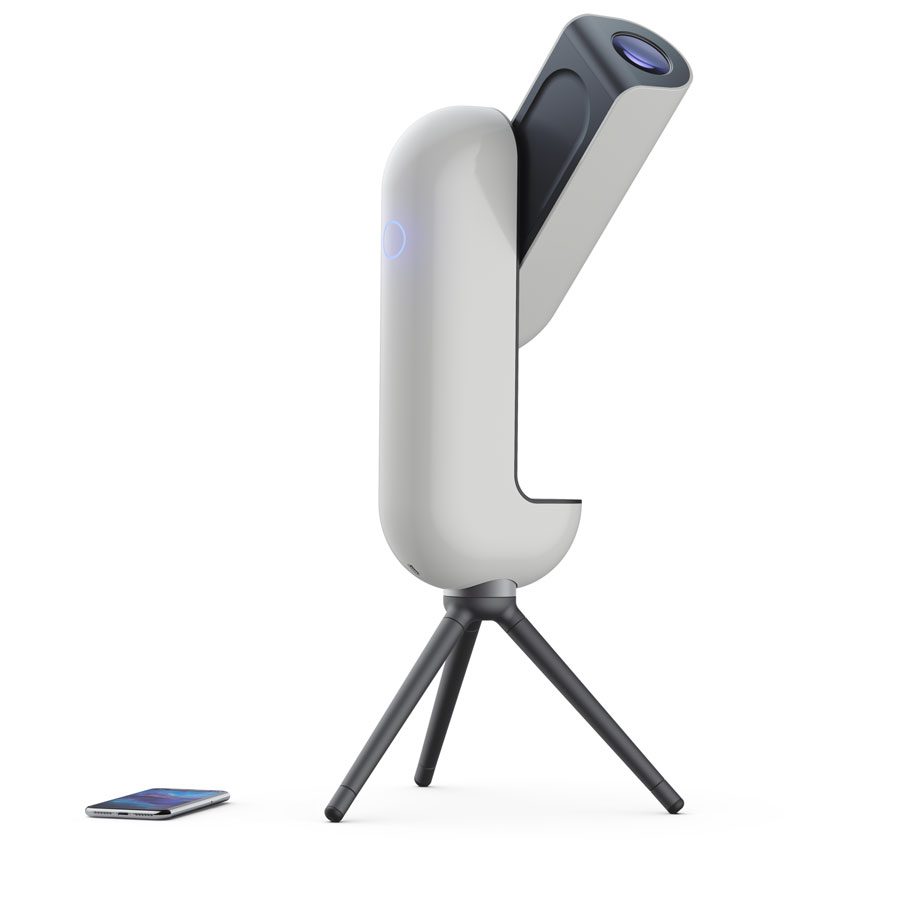 |
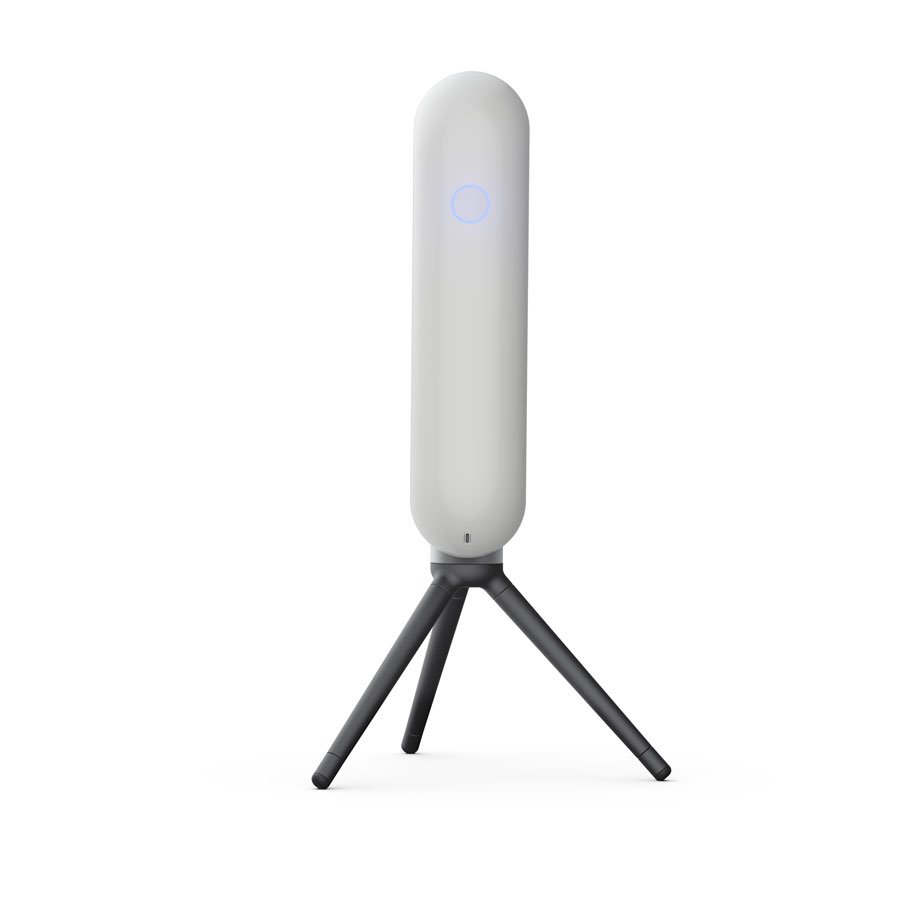 |
|
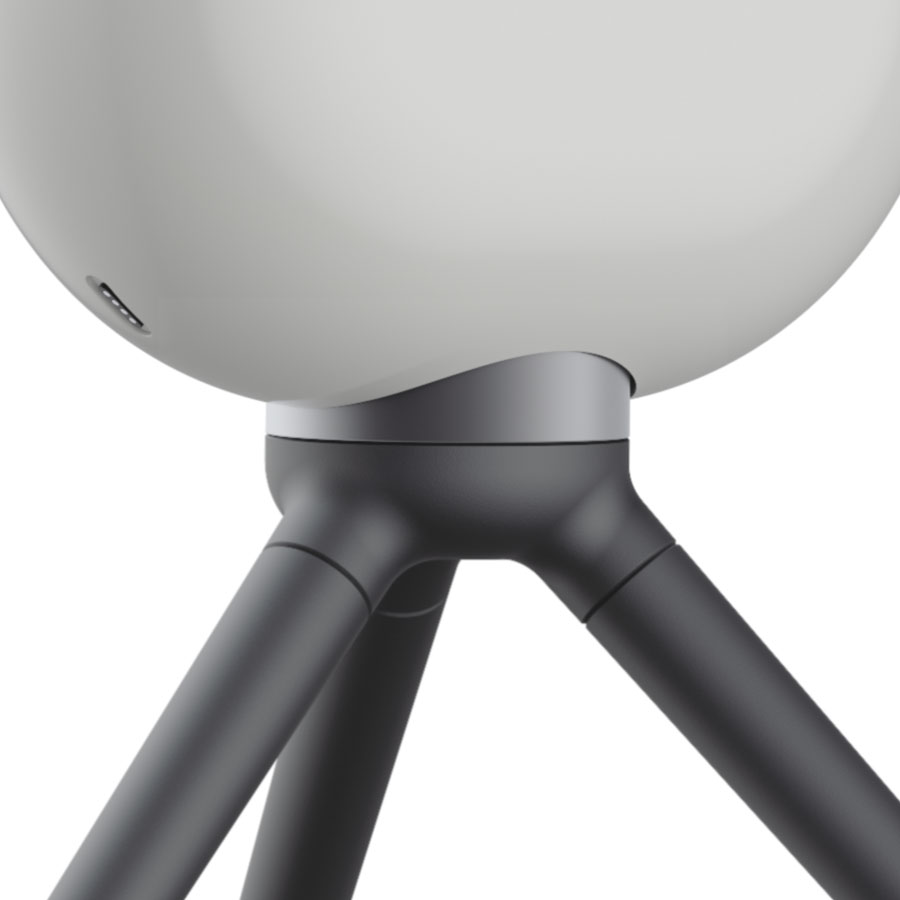 |
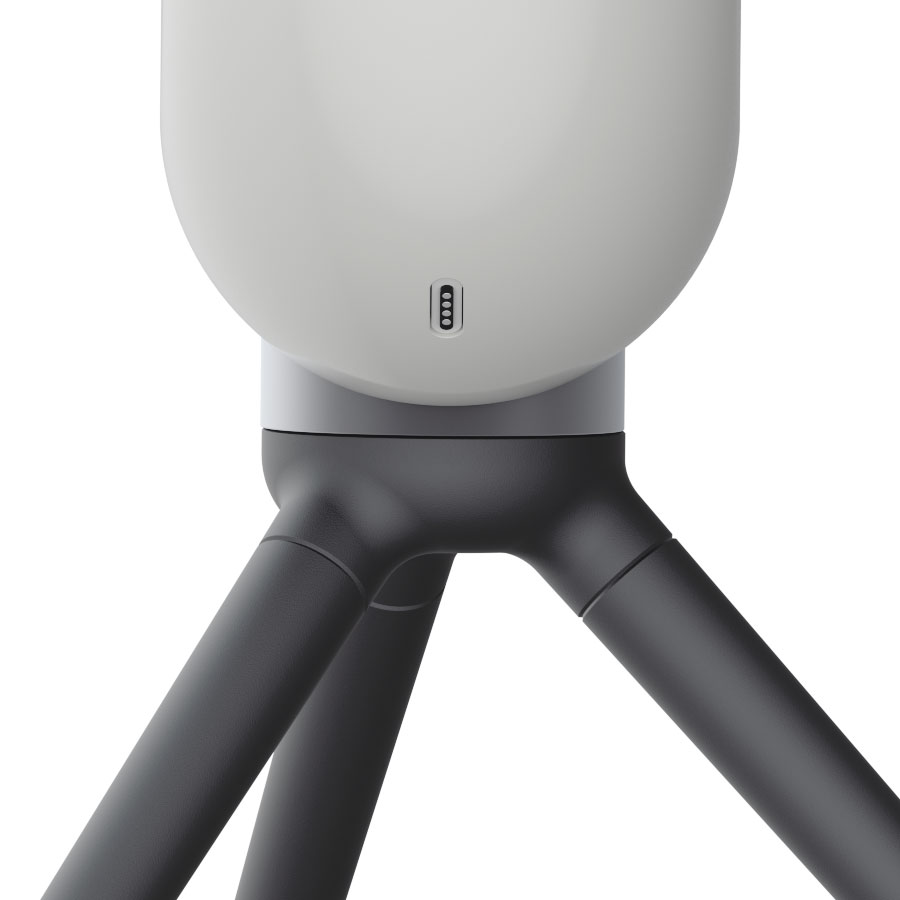 |
|
Detail |
Detail |
|
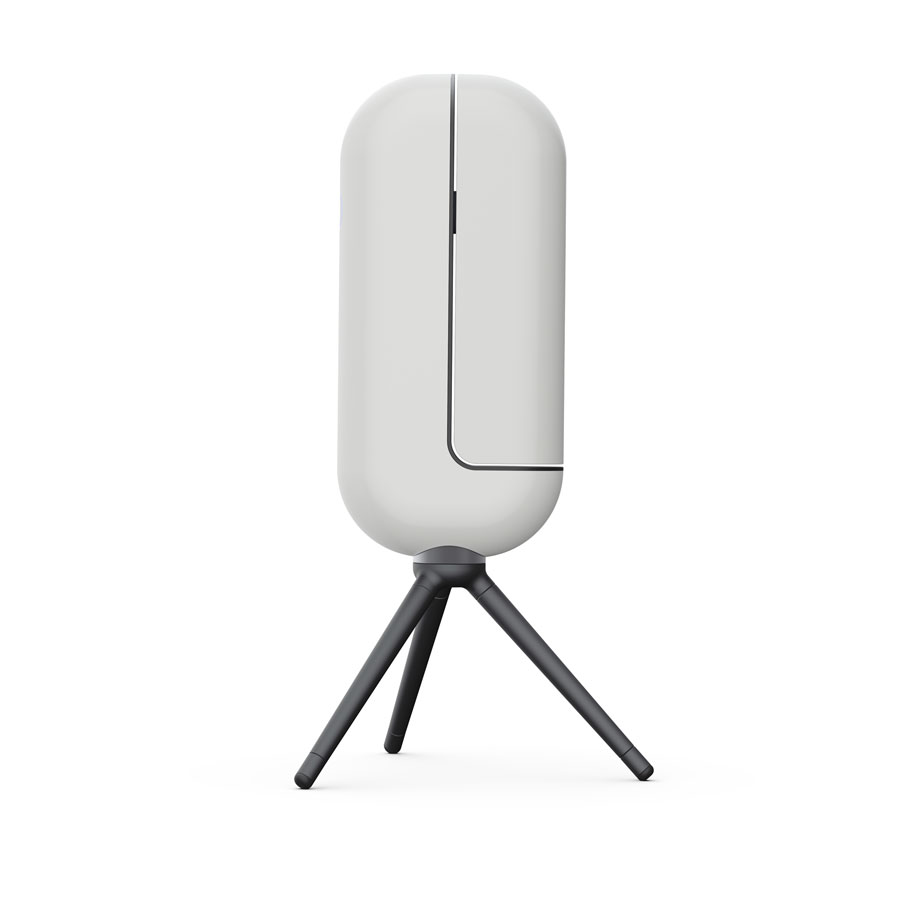 |
||
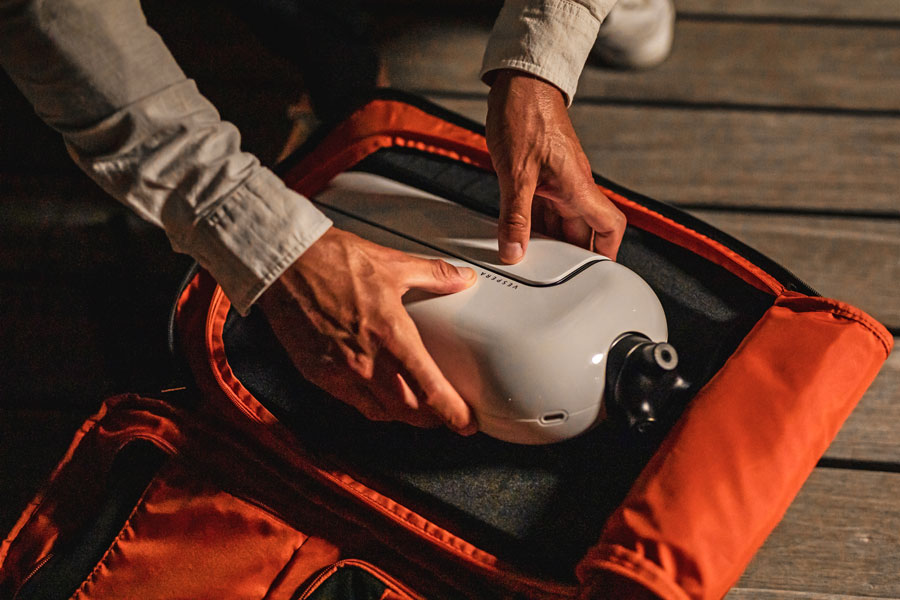 |
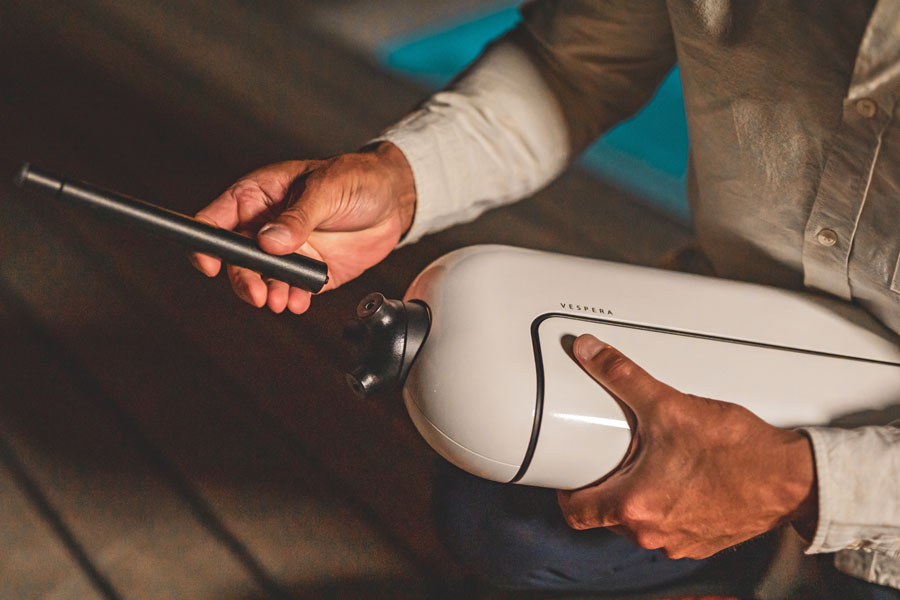 |
(Photos from the Vaonis press kit (EN); permission for use granted)
Backpack, Accessories
For up-to-date photos, see page Adventurer Pack and More Accessories.
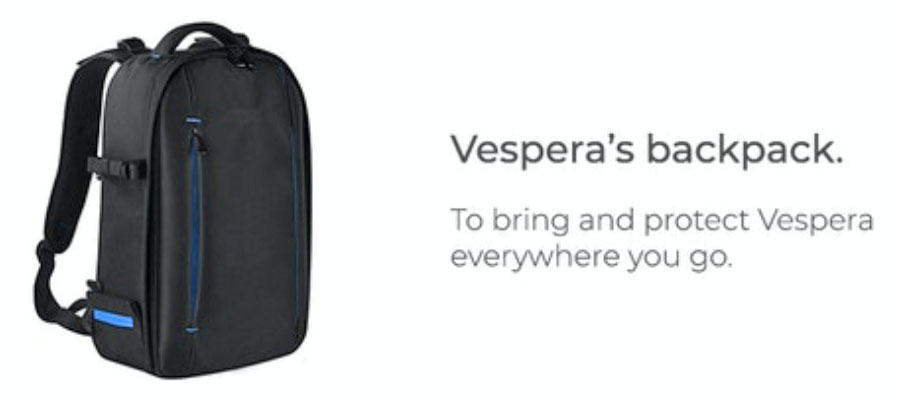 |
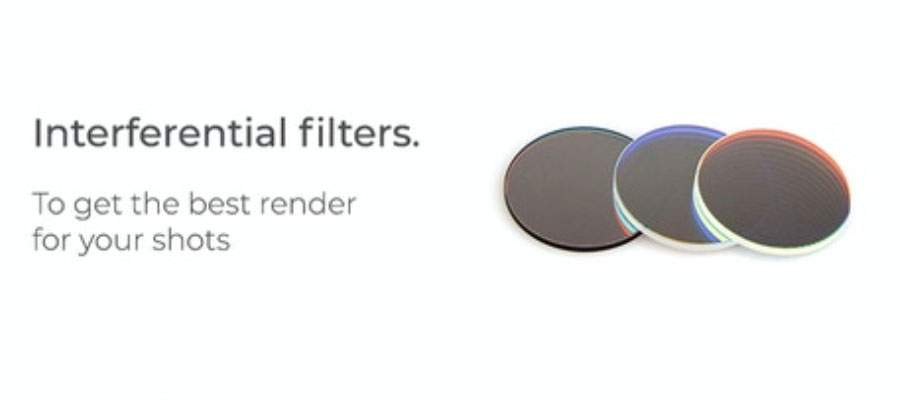 |
|
Backpack |
Filters |
|
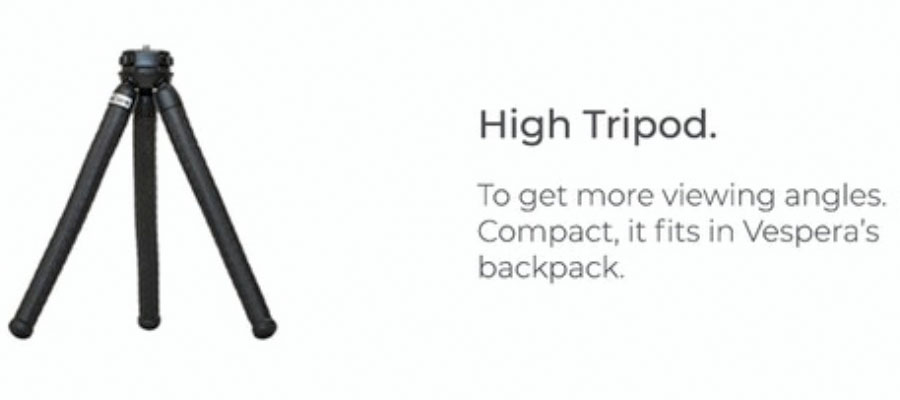 |
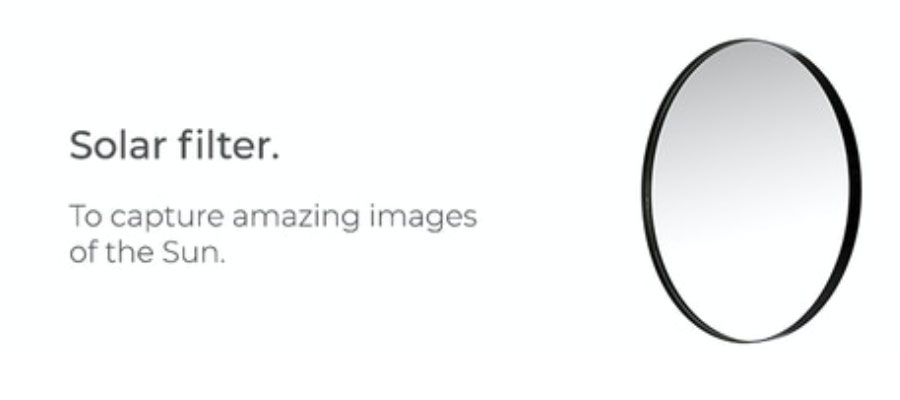 |
|
High tripod |
Solar filter |
(Photos from the Vaonis-Website (EN); permission for use granted)
Appendix: Photos
Here I present photos from Vaonis that were taken with prototypes of the Vespera telescope.
The photos were taken by Vaonis in a Bortle 6 area, in the South of France. (Photos from the Vaonis-Website (EN) /press kit; permission for use granted; simulations created with Stellarium)
New Sample Photos from the Testing Phases End of 2021
Pictures taken by the Vaonis team members during the testing phases that have been carried out in November/December 2021:
Appendix: Project Schedule and Delivery
Project Schedule (from Vaonis/Kickstarter)
Original Project Schedule
- December 2019: Project starts
- March 2020: Main specs & design choices
- July 2020: First prototype (mechanic and optic)
- September 2020: Validation of two mechanical prototypes and one electronic prototype (camera and embedded computer)
- October 1, 2020: Kickstarter launch
- October 31, 2020, Kickstarter campaign ends
- December 2020: Manufacturing of injection molds
- January 2021: Testing and launch of productin line
- April 2021: Reception of parts for pre-series first batch
- June 2021: Pre-series second batch
- August 2021: Mass production
- November/December 2021: End of mass production and shipping for Kickstarter backers.
Updated Project Schedule (End of November 2020)
- March 2020: Main specs & design choices
- July 2020: First prototype (mechanic and optic)
- September 2020: Validation of two mechanical prototypes and one electronic prototype (camera and embedded computer)
- October 1, 2020: Kickstarter launch
- October 31, 2020: Kickstarter campaign ends
- December 2020: Kick-off meeting with industrial partners (injection molds, assembly line, supply chain)
- January 2021: Tests of the last industrial prototype
- February 2021: Reception of the first prototypes of accessories
- March 2021: Product regulatory compliance
- April 2021: Launch of a few pre-series Vesperas for tests and production line adjustments
- May 2021: Integration of Vespera in the existing mobile app (Stellinapp)
- June 2021: Finalization of packaging
- July 2021: Start of mass production
- August 2021: Testing of accessories
- September 2021: Confirmation of backers' shipping address and payment of local taxes
- October 2021: First reviews
- November 2021: Start of shipping
- December 2021: Mass delivery
Updated Project Schedule (End of May 2021): Key Milestones
- May 2021: Product regulatory compliance (EMC, electrical safety...)
- June 2021: Launch of a few pre-serie Vespera's
- July 2021: Start of mass production
- August 2021: Testing of accessories
- September 2021: Integration of Vespera into the mobile app
- October 2021: Confirmation of backers' shipping address and payment of local taxes
- December 2021: First shipments of Vespera
Delivery
Update (Nov 8, 2021): The delivery of Vespera was postponed, only 400 "Basic" versions were delivered to the USA at the end of 2021. My version ("Adventurer") will not be delivered in Europe until the second quarter of 2022. Here is the updated delivery plan published by Vaonis:
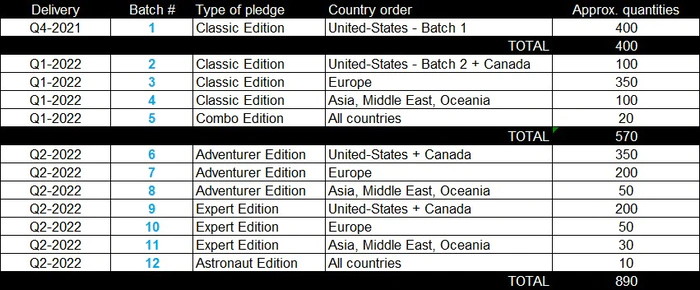
Update (Feb 11, 2022): In February 2022, an updated timeline was published by Vaonis:
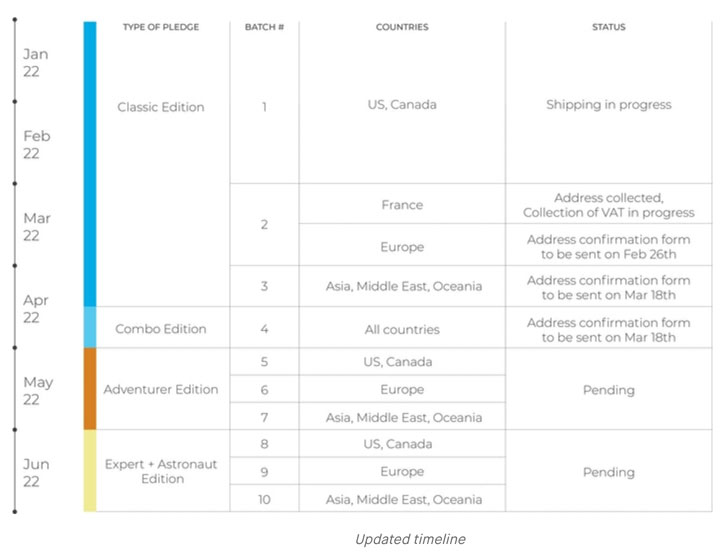
Update: On July 28, 2022, I received an e-mail from UPS stating that my Vespera will arrive at my home on July 29, 2022. And indeed, it did arrive on that day! My accessories (Adventurer Pack) arrived on September 15, 2022.
| 30.03.2025 |
